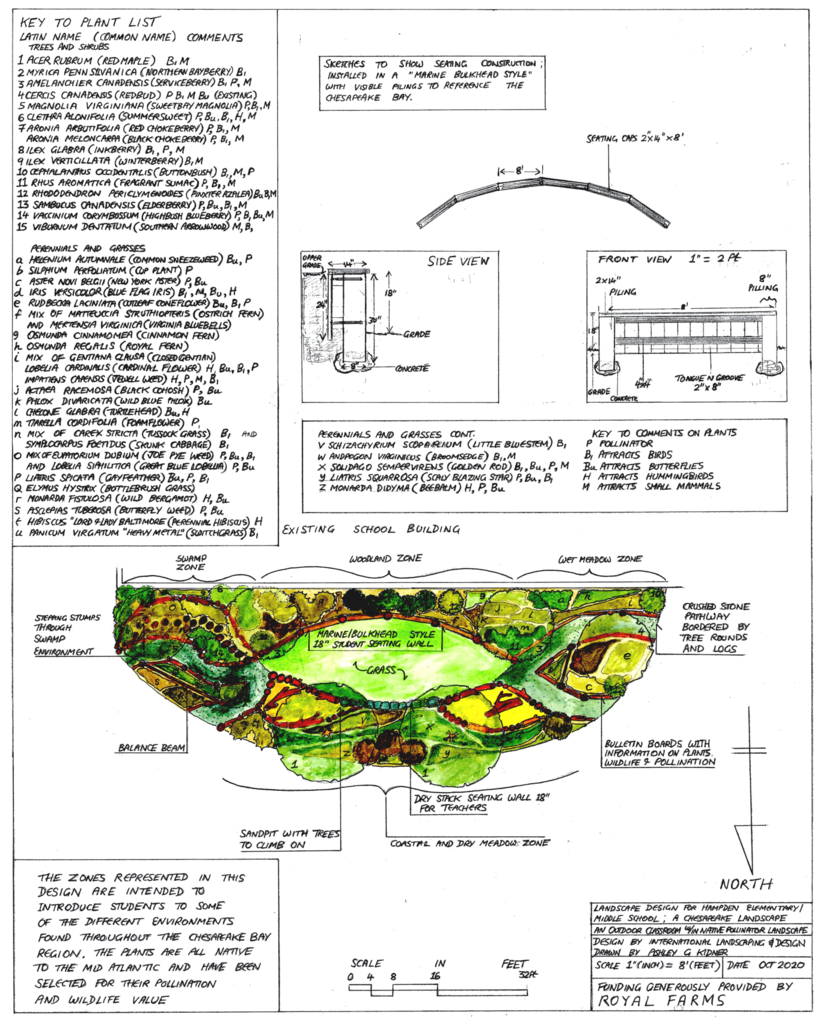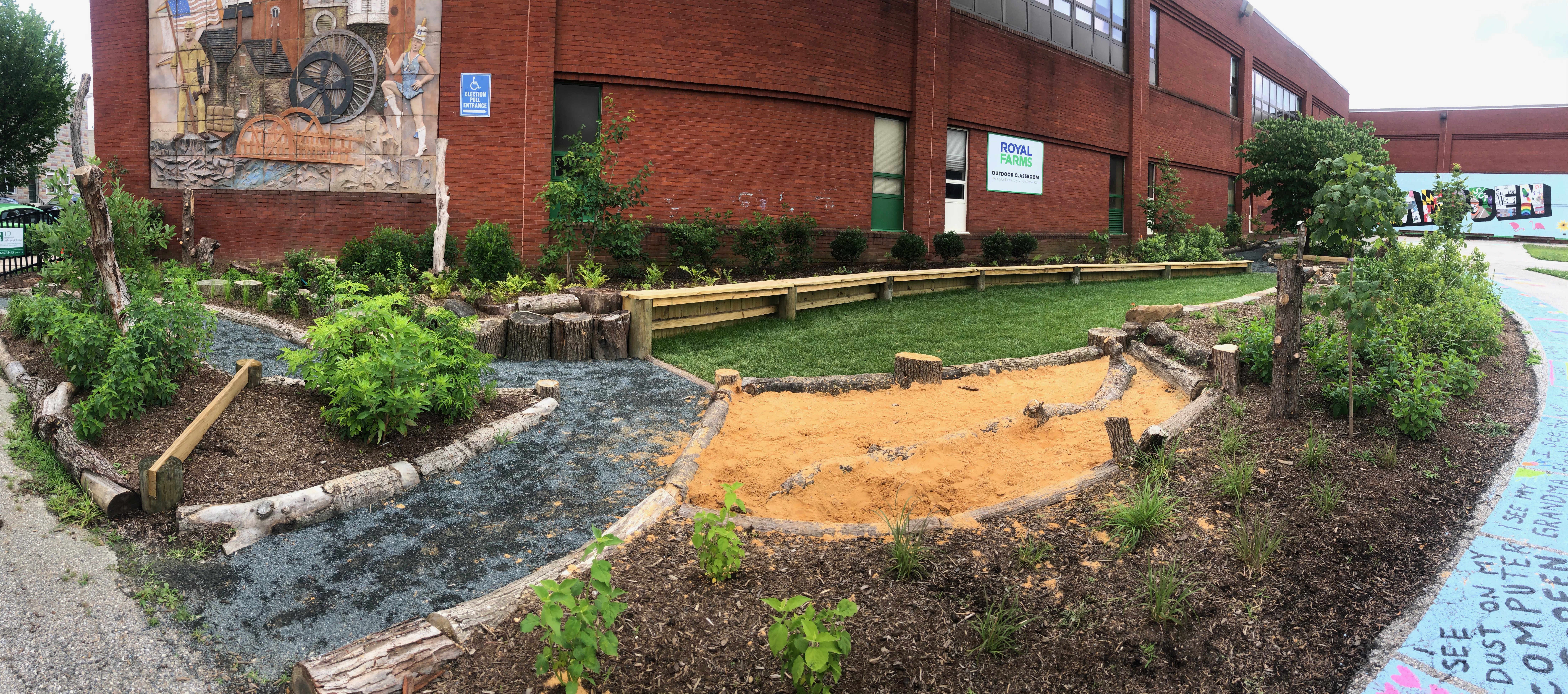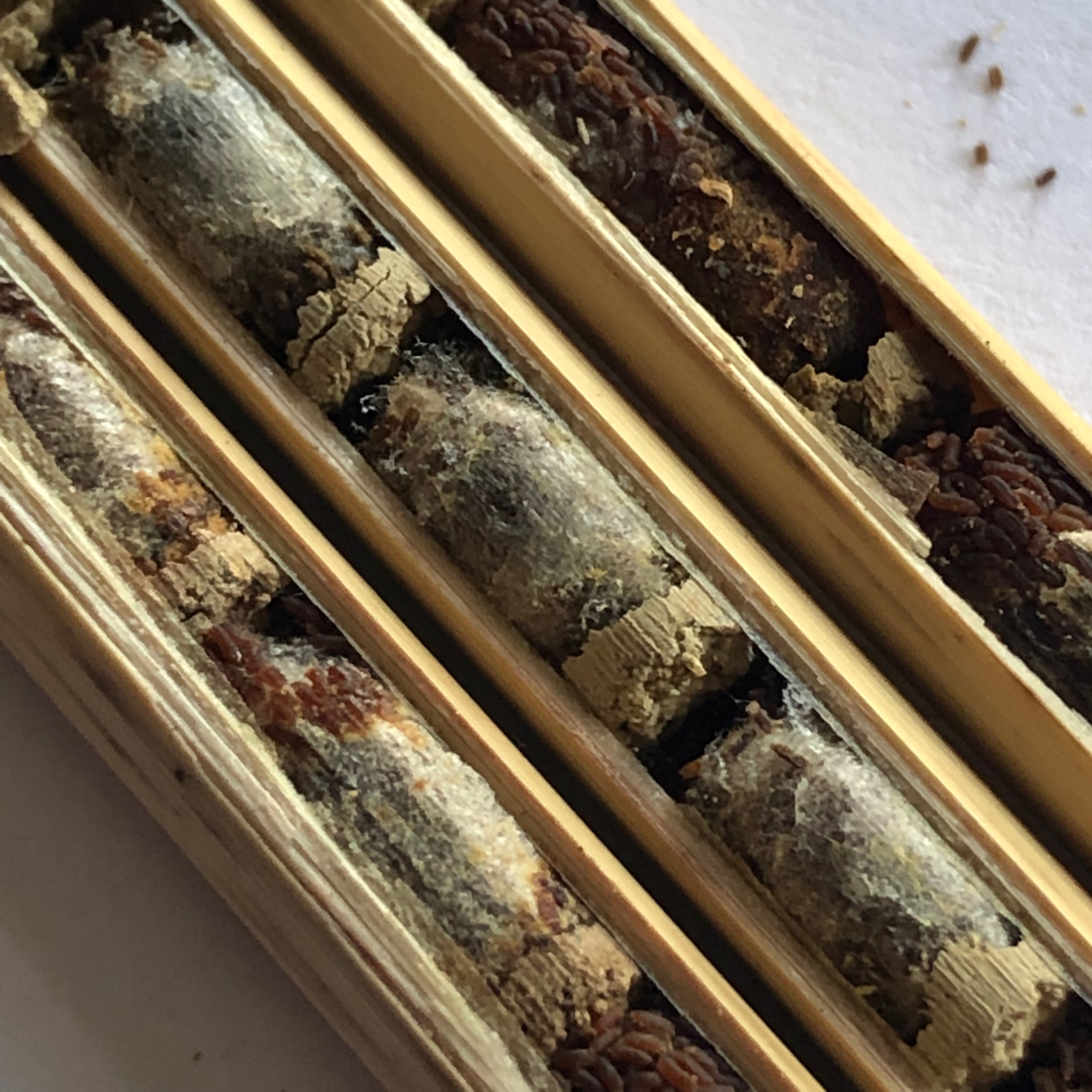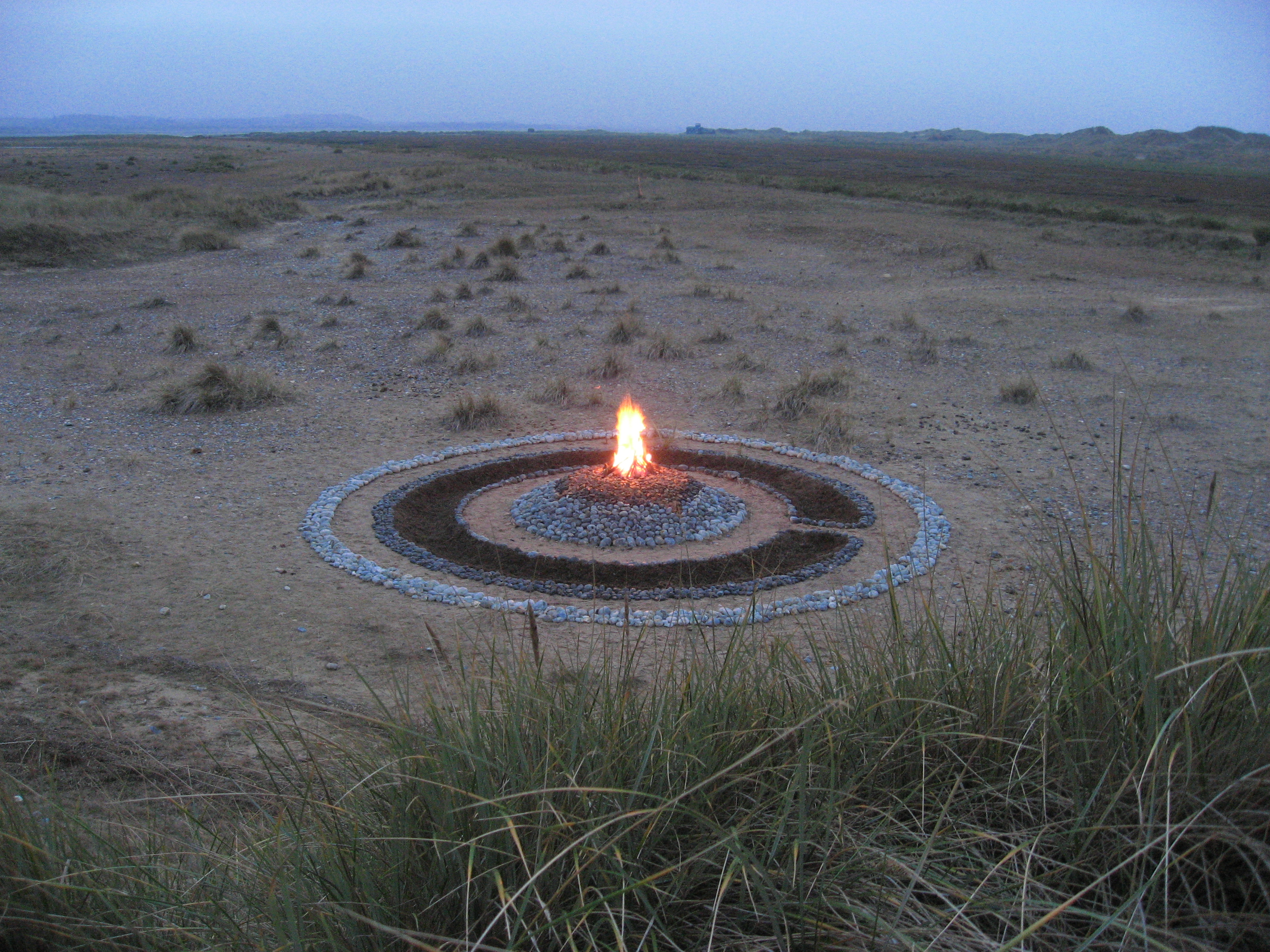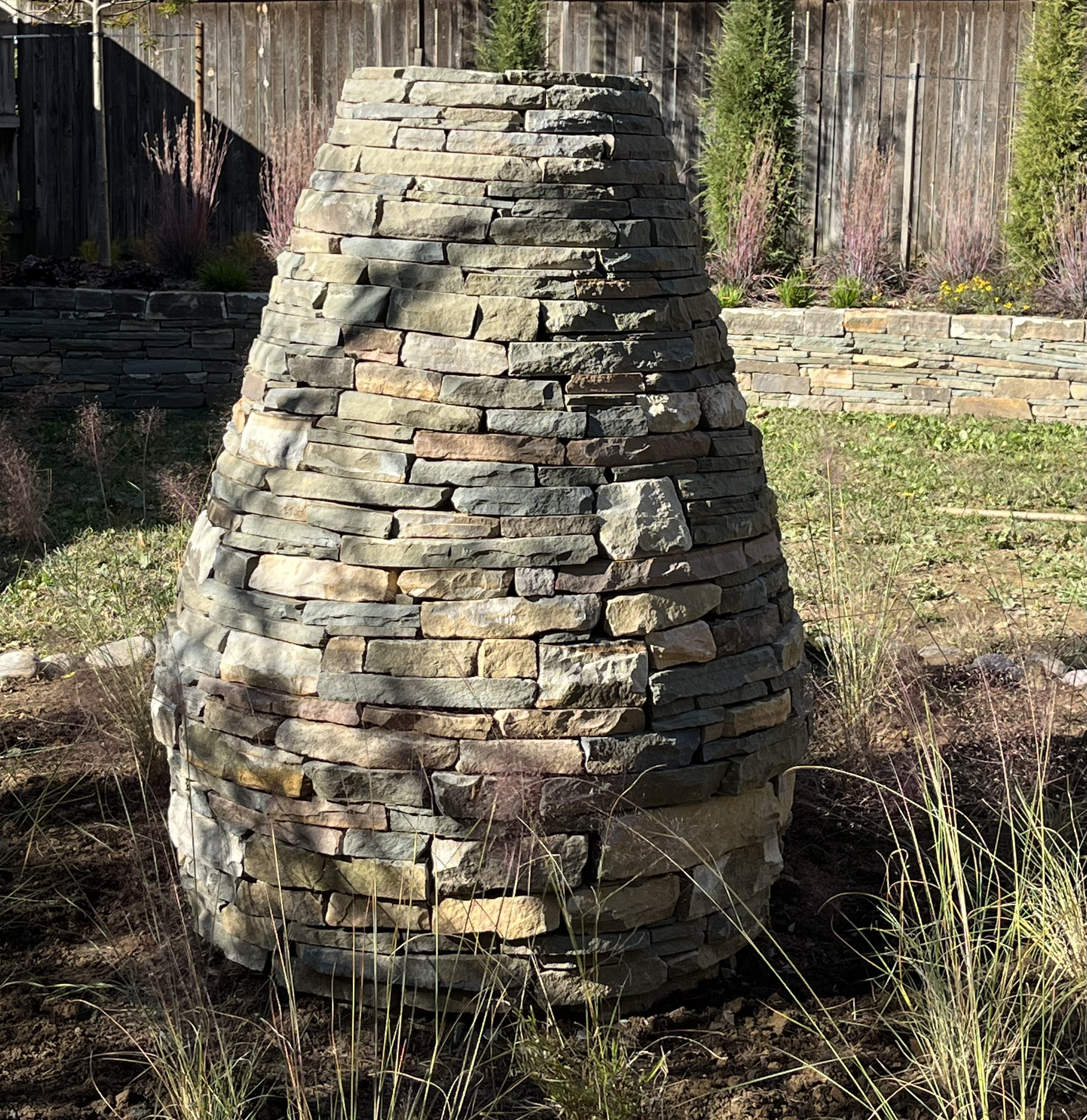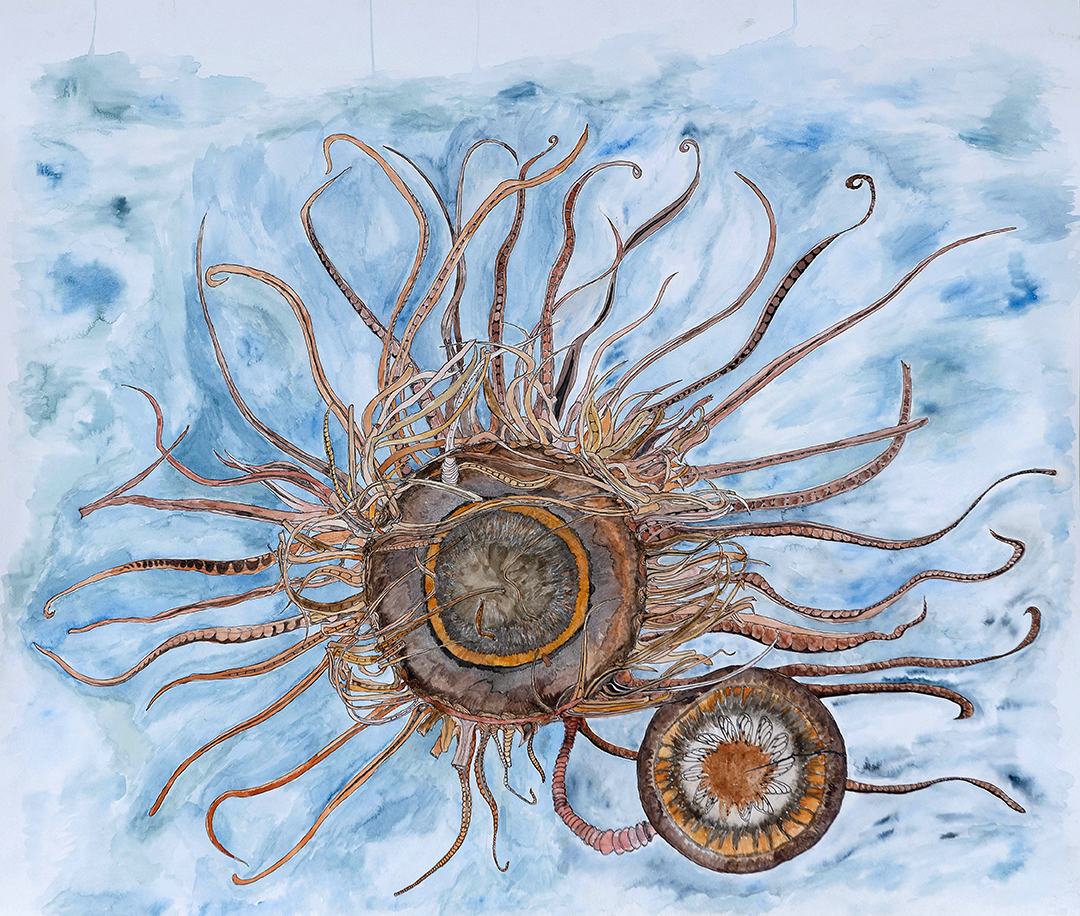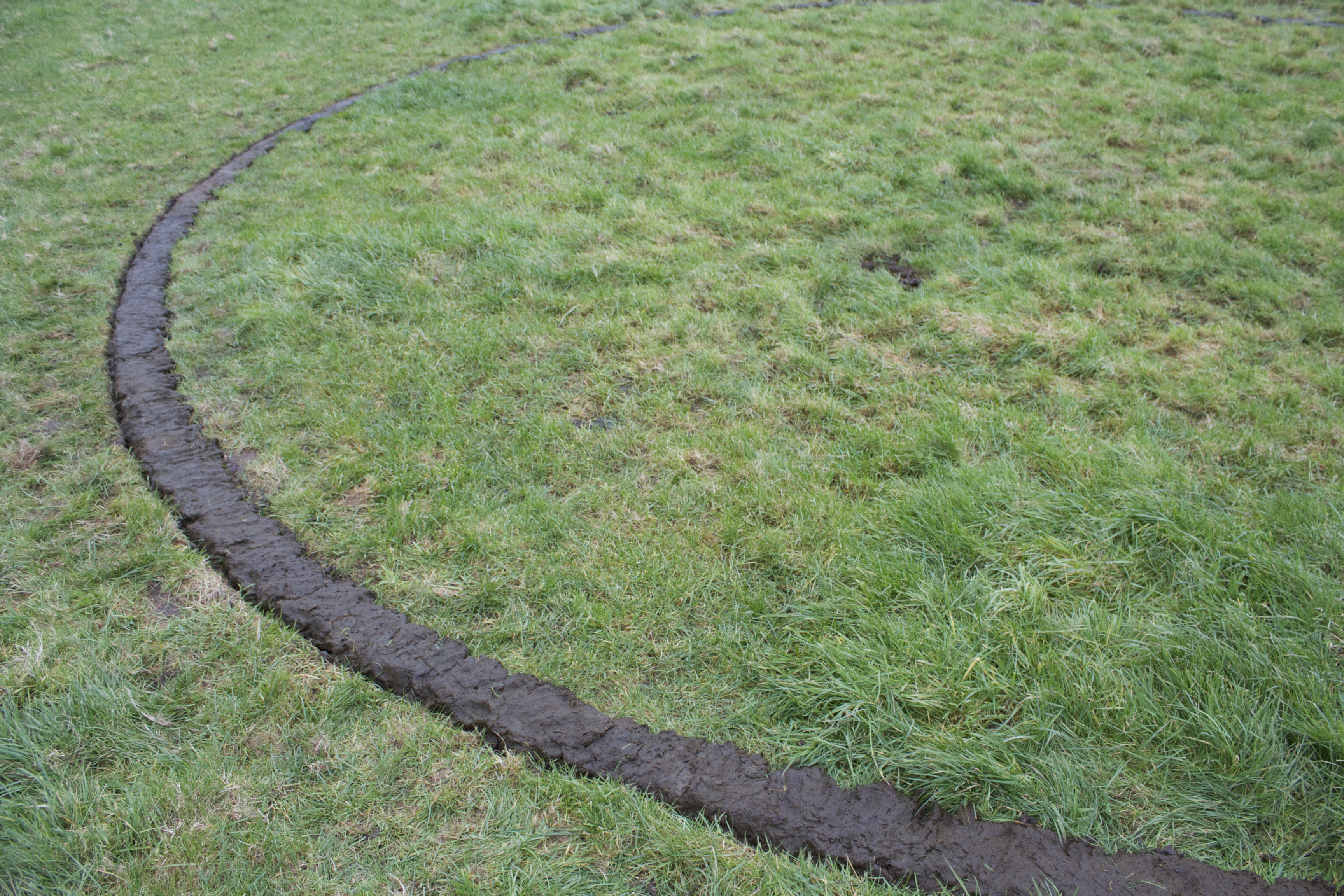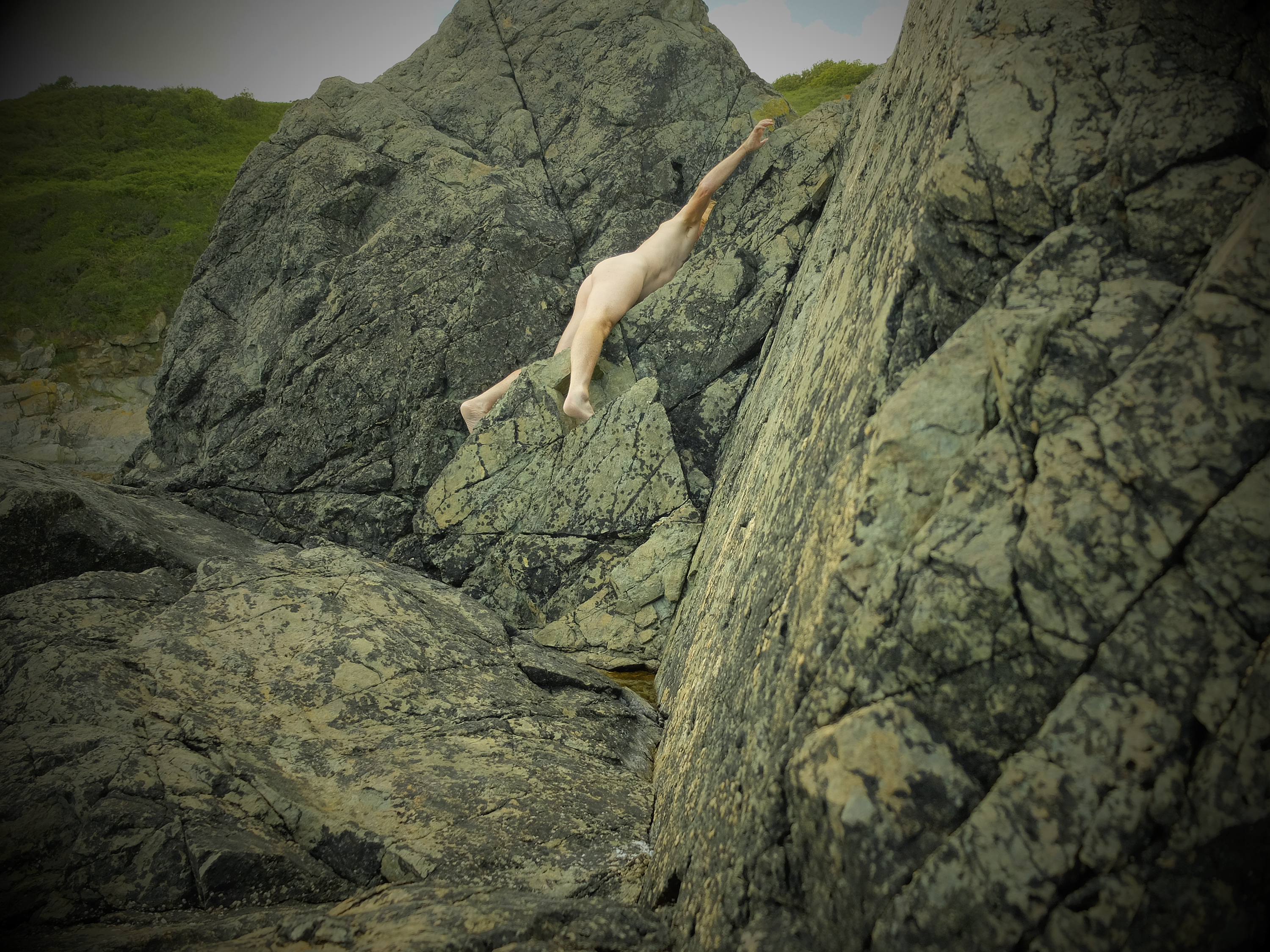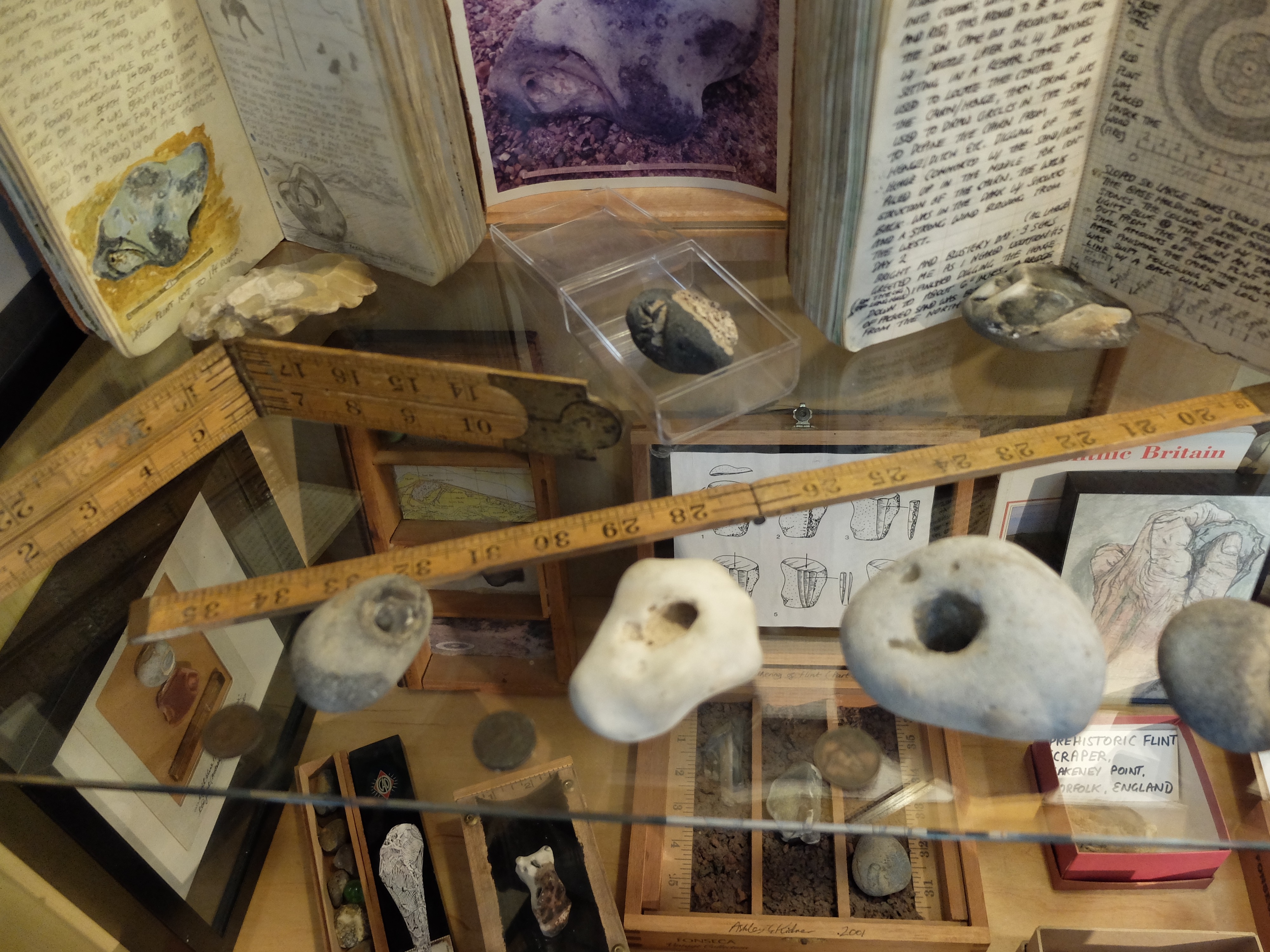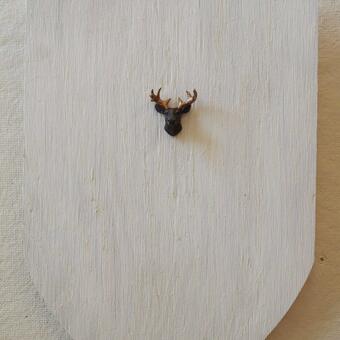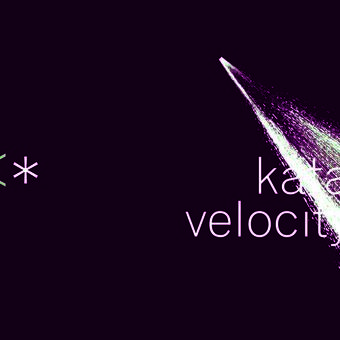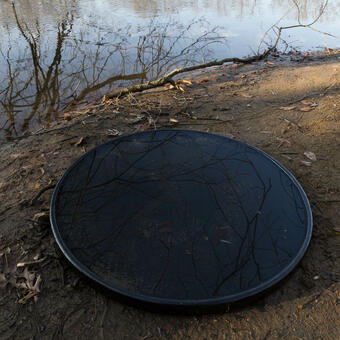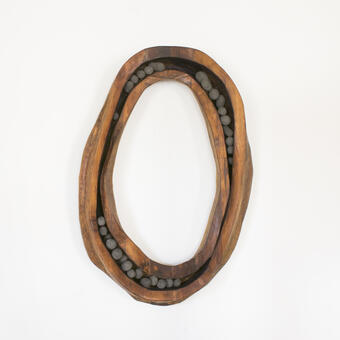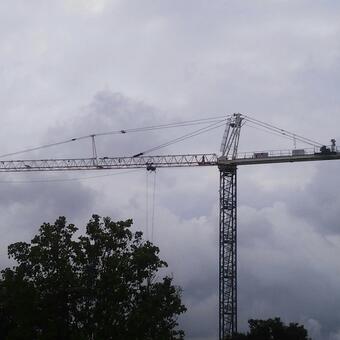About ashley
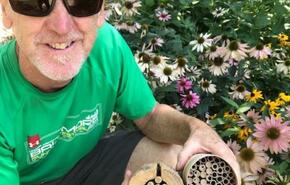
Ashley Kidner is a Baltimore based environmental artist. Kidner’s work reflects issues such as global warming, habitat loss, sea level rise and the decline of pollinators. Kidner likes to work with natural materials like stone, wood, plants and water when doing earthwork installations in different locations around the world. When in the studio Kidner works with a variety of mediums ranging from watercolors and printmaking to encaustics.
In addition to environmental artwork Kidner… more
Hampden elementary and middle school (HEMS) outdoor classroom and Druid Heights Nature Playspace
The Druid Heights Nature Playspace project involved transforming 2 empty lots on McCulloh St in the Druid Heights area into a community nature playspace with an emphasis on sustainability and native pollinator plants. The design was drawn up by myself with help and advice from The Druid Heights Development Corporation, National Wildlife Federation, The Univesity of MD Medical Center and the US Fish and Wildlife Service. The installation was completed by my company International Landscaping and Design over a period of approximately 8 months in 2019.
https://blog.nwf.org/2019/08/bringing-nature-play-to-west-baltimore/?_ga=2.243302278.2098123358.1576712363-1506711329.1576529155
-
 Hems Outdoor classroom and educational play space 2021
Hems Outdoor classroom and educational play space 2021 -
HEMS outdoor class room and play space, 2021The HEMS project involved designing and installing an outdoor classroom and educational playspace featuring a native pollinator and wildlife garden, installed by my company International Landscaping and Design.
-
HEMS outdoor classroom and play space, 2021The HEMS project involved designing and installing an outdoor classroom and educational playspace featuring a native pollinator and wildlife garden, installed by my company International Landscaping and Design.
-
Rep. Elijah Cummings Nature playspace dedication in BaltimoreThis video has a small clip of the late great Elijah Cummings dedicating the playspace in august of 2019
-
 Bridge over dry stream bedOverhead view of the Playspace showing a bridge over the dry stream bed which leads to the rain garden.
Bridge over dry stream bedOverhead view of the Playspace showing a bridge over the dry stream bed which leads to the rain garden. -
 Solitary bee house at center of labyrinthThis bee house will provide a nesting site for native bees, most likely mason and leafcutter bees.
Solitary bee house at center of labyrinthThis bee house will provide a nesting site for native bees, most likely mason and leafcutter bees. -
 Playspace view from McCulloh St. (east)View showing playspace features such as hopscotch, sandpit with log jumps and the winding path with bridge in the background.
Playspace view from McCulloh St. (east)View showing playspace features such as hopscotch, sandpit with log jumps and the winding path with bridge in the background. -
 View of rain garden from the west side of the playspaceThis view shows the rain garden which captures nearly all of the water that falls on the site. The plants in the foreground are rudbeckia fulgida (coneflower).
View of rain garden from the west side of the playspaceThis view shows the rain garden which captures nearly all of the water that falls on the site. The plants in the foreground are rudbeckia fulgida (coneflower). -
 This view shows the steps and tee pee grow art structureThe tee pee grow art structure is made from bamboo canes with native vines growing up, one of the cypress benches is also visible.
This view shows the steps and tee pee grow art structureThe tee pee grow art structure is made from bamboo canes with native vines growing up, one of the cypress benches is also visible.
Birdland and the Anthropocene exhibition at the Peale Center (2017)
https://www.thepealecenter.org/wp-content/uploads/2017/08/finalbirdland.pdf
-
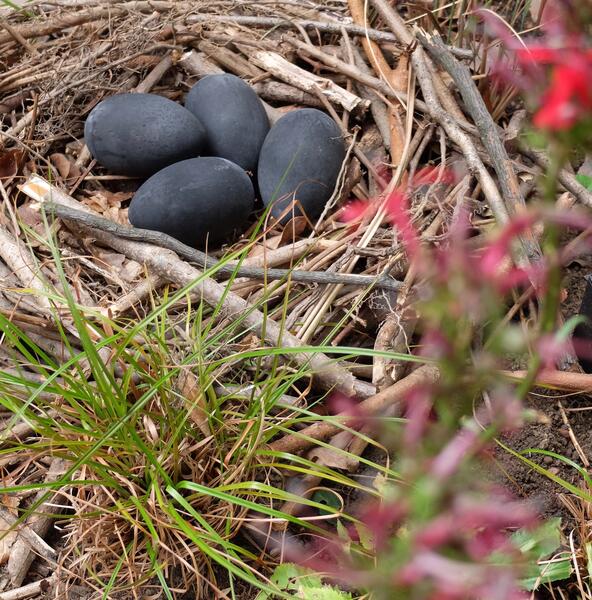 Brown Pelican nest detailPelecanus occidentals (Brown pelican) nest detail
Brown Pelican nest detailPelecanus occidentals (Brown pelican) nest detail -
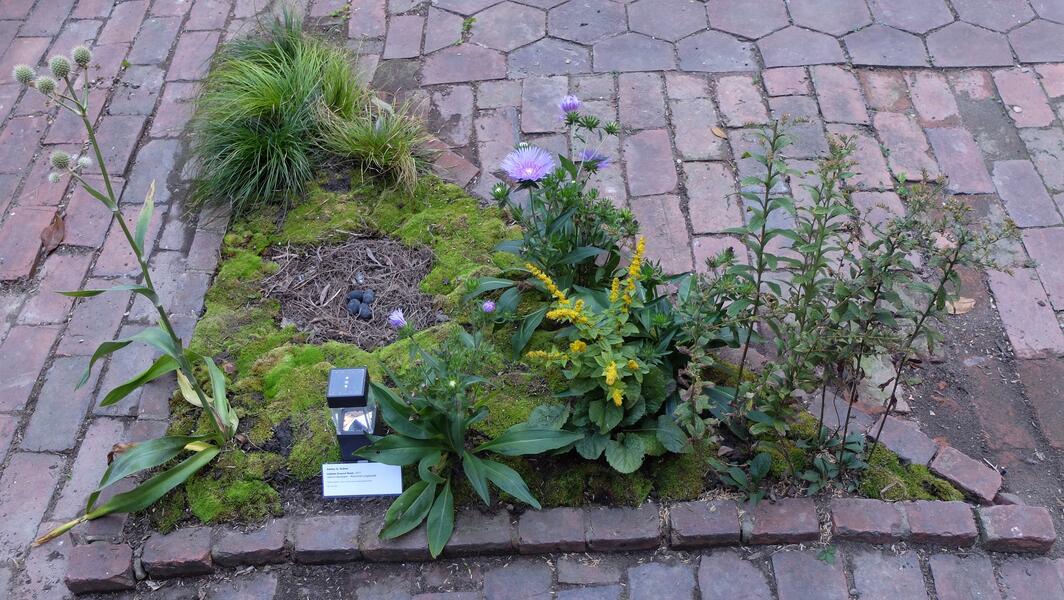 Upland Sandpiper nestBartransia longicauda (Upland sandpiper) nest
Upland Sandpiper nestBartransia longicauda (Upland sandpiper) nest -
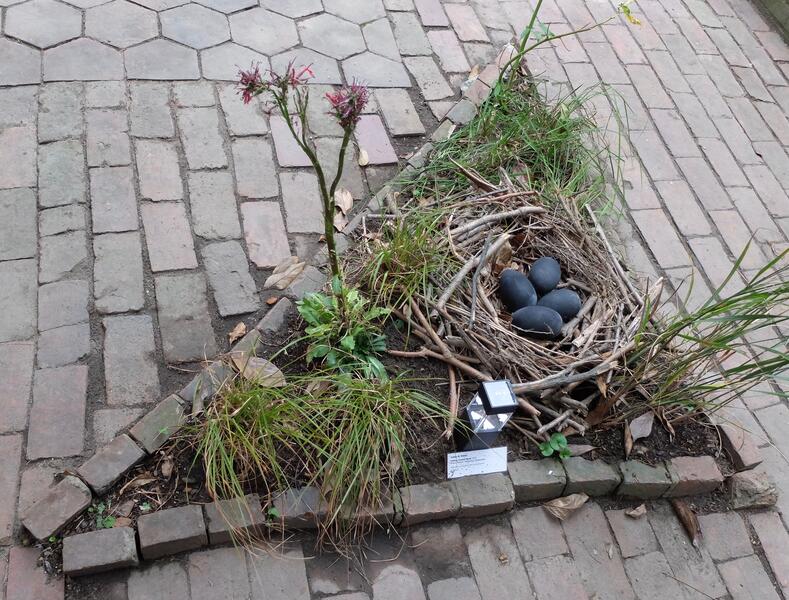 Brown Pelican nestPelecanus occidentalis (Brown Pelican) nest
Brown Pelican nestPelecanus occidentalis (Brown Pelican) nest -
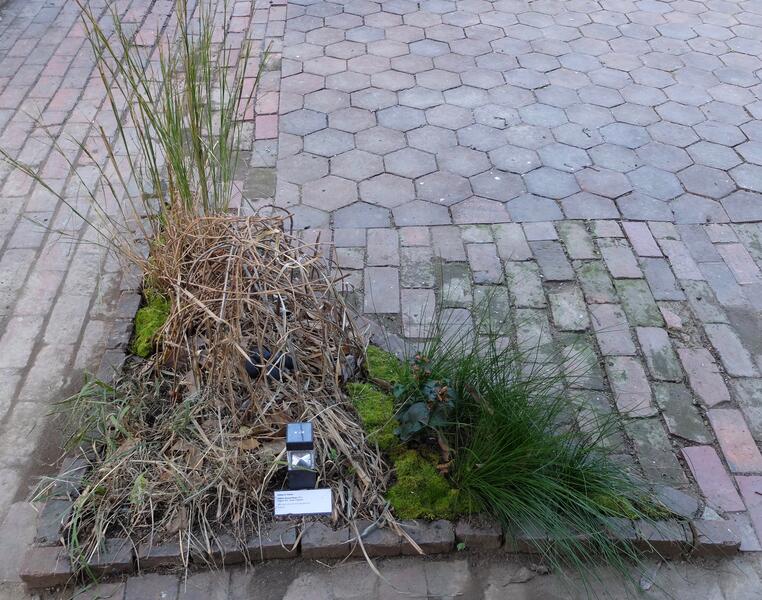 Clapper Rail nest.Rullus crepitans (Clapper rail) nest
Clapper Rail nest.Rullus crepitans (Clapper rail) nest -
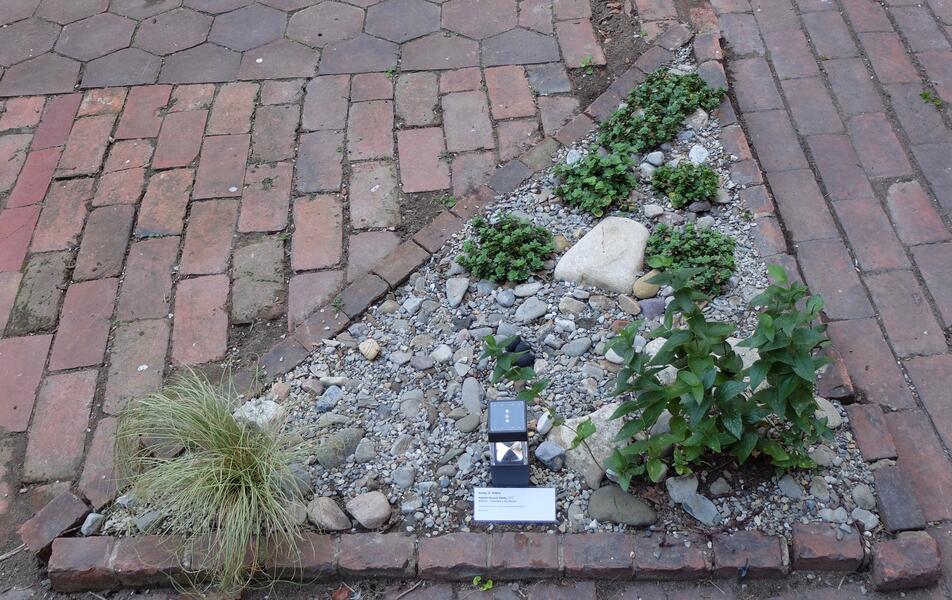 Killdeer nest.Killdeer nest, (Charadrius vociferus)
Killdeer nest.Killdeer nest, (Charadrius vociferus) -
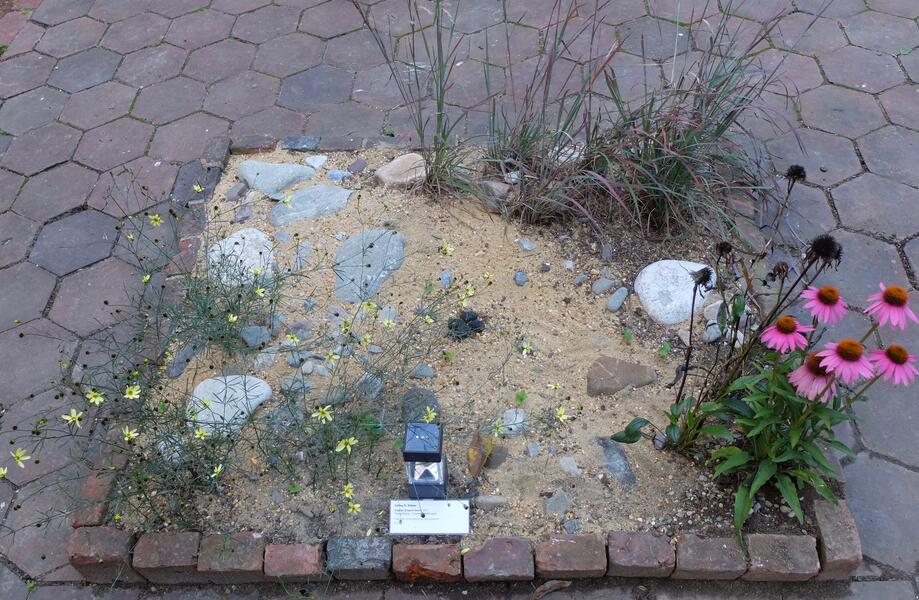 Piping Plover nestCharadrius melodus (Piping plover) nest
Piping Plover nestCharadrius melodus (Piping plover) nest -
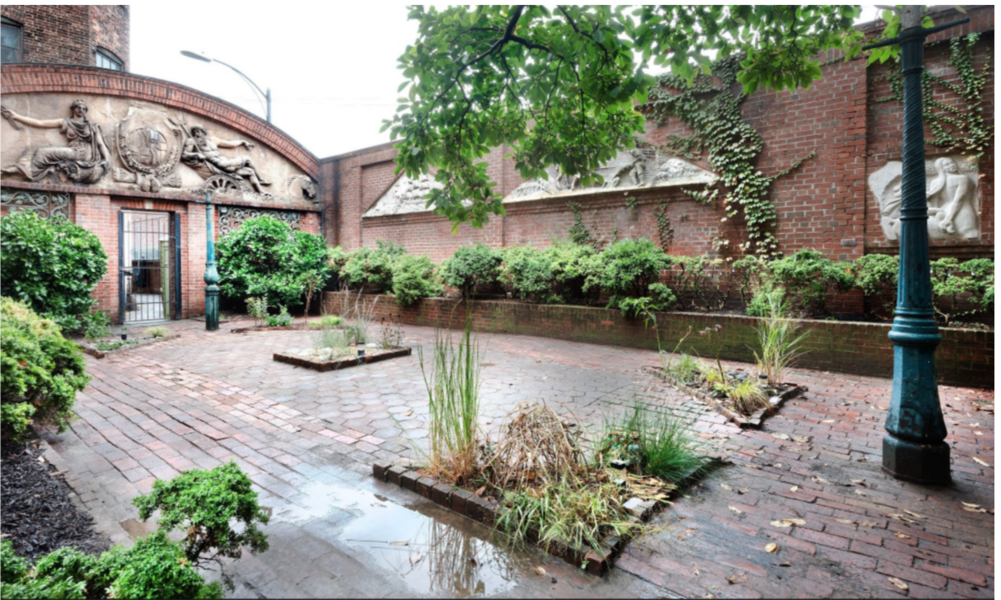 Habitat Ground Nests.The Peale Center garden, showing the 5 small spaces where the replica nests were installed. The triangular spaces measured 4ft by 4ft by 5ft 8inches and the central rectangular space 4ft by 3ft. Photo by Joe Hyde.
Habitat Ground Nests.The Peale Center garden, showing the 5 small spaces where the replica nests were installed. The triangular spaces measured 4ft by 4ft by 5ft 8inches and the central rectangular space 4ft by 3ft. Photo by Joe Hyde. -
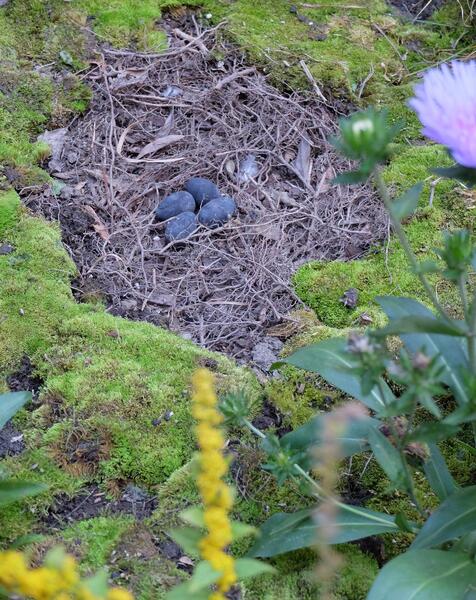 Upland sandpiper, Nest detail.Bartransia longicauda (Upland Sandpiper) nest
Upland sandpiper, Nest detail.Bartransia longicauda (Upland Sandpiper) nest -
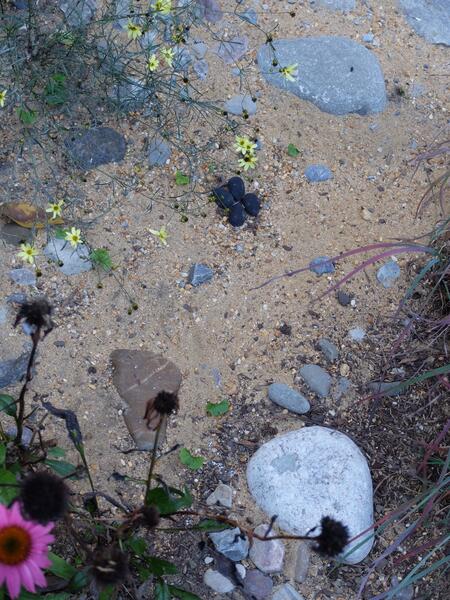 Piping plover nest detail
Piping plover nest detail -
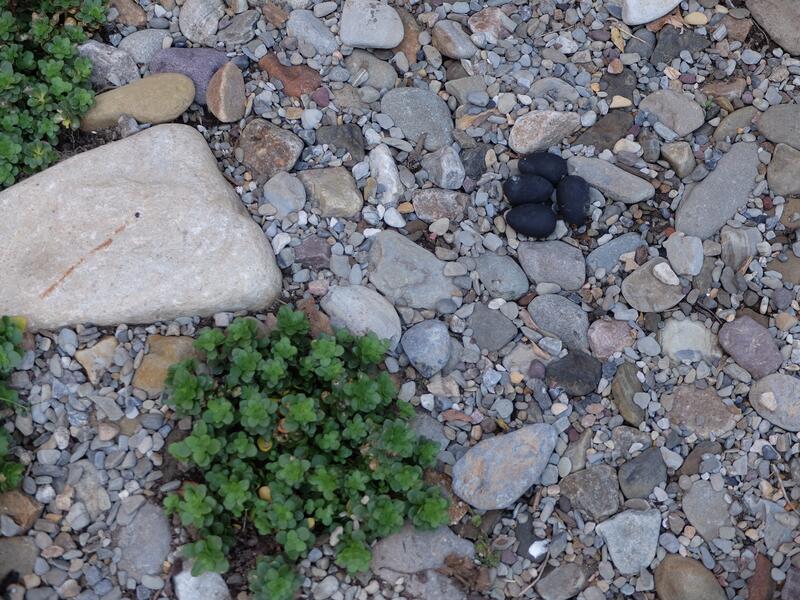 Killdeer nest detail
Killdeer nest detail
Box Constructions
Assemblages: Wood, stone, oil paint, sand, photographs, natural and manmade objects.
-
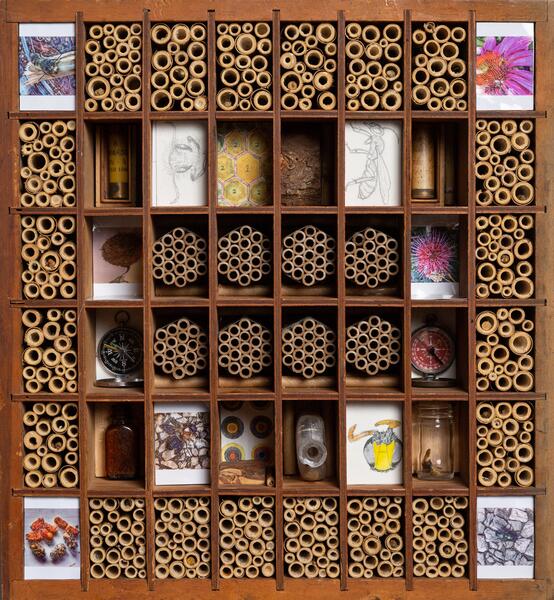 BEE HOUSE (2019)BEE HOUSE; Mixed media, 23" by 23"(2021). This box construction consists of bee tubes as used in solitary bee houses along with paintings, drawings and polaroids of work associated with solitary bees, specifically mason and leaf cutter bees. The box was shown at the Peale Center as part of the Baker Off the Web show and is now in a private collection.
BEE HOUSE (2019)BEE HOUSE; Mixed media, 23" by 23"(2021). This box construction consists of bee tubes as used in solitary bee houses along with paintings, drawings and polaroids of work associated with solitary bees, specifically mason and leaf cutter bees. The box was shown at the Peale Center as part of the Baker Off the Web show and is now in a private collection. -
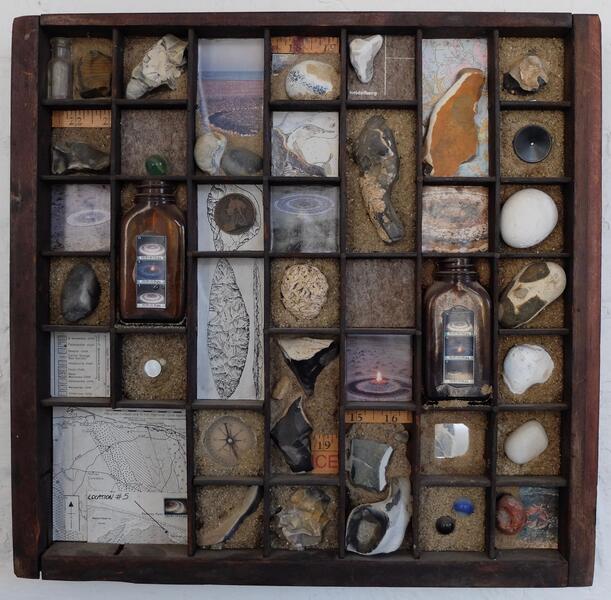 The age of flint 2005Box assemblage; collected flint, bottles, photographs, marbles, mirrors, geological drawings and text. 18" by 18"
The age of flint 2005Box assemblage; collected flint, bottles, photographs, marbles, mirrors, geological drawings and text. 18" by 18" -
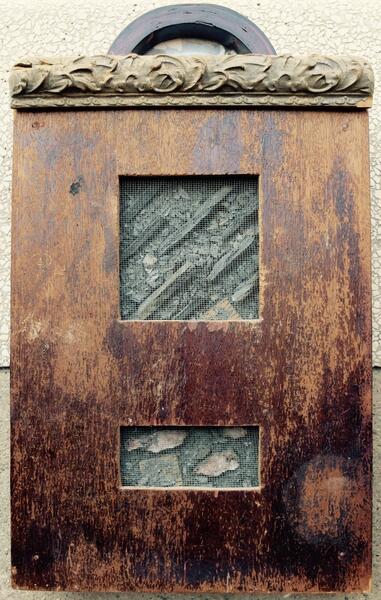 Death by Cleavage 1991Box assemblage; stone, ruler. 12" by 16"
Death by Cleavage 1991Box assemblage; stone, ruler. 12" by 16" -
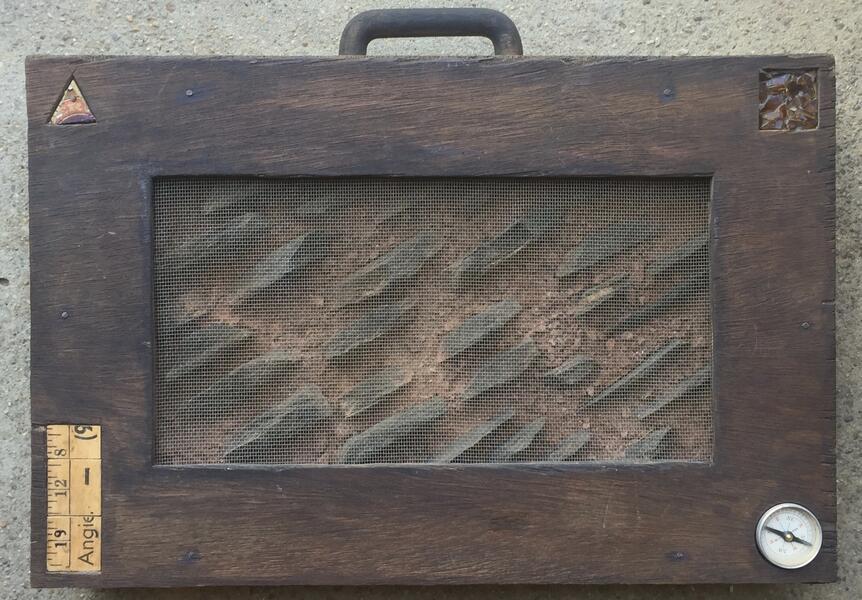 Death by Cleavage IV 1994Box assemblage; slate with red sandstone. 16" by 10"
Death by Cleavage IV 1994Box assemblage; slate with red sandstone. 16" by 10" -
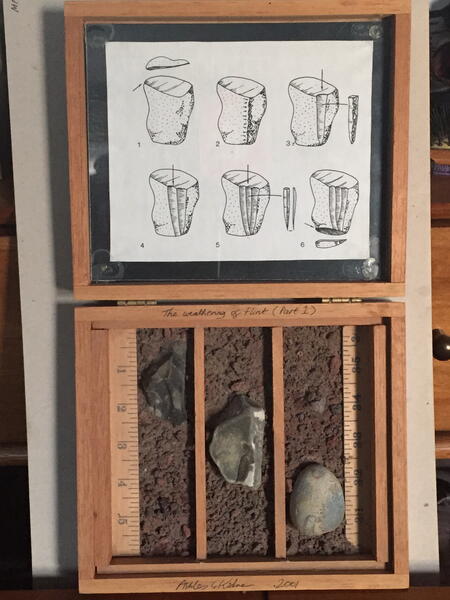 The weathering of flint (pt. 1) (2005)Box assemblage constructed with flint,stonedust, wooden ruler.
The weathering of flint (pt. 1) (2005)Box assemblage constructed with flint,stonedust, wooden ruler. -
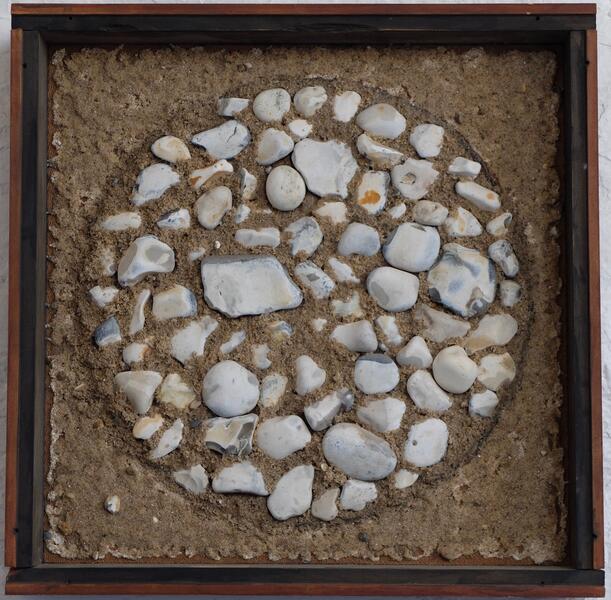 White flint circle 2005Box assemblage; flint with sand and glue. 14" by 14"
White flint circle 2005Box assemblage; flint with sand and glue. 14" by 14" -
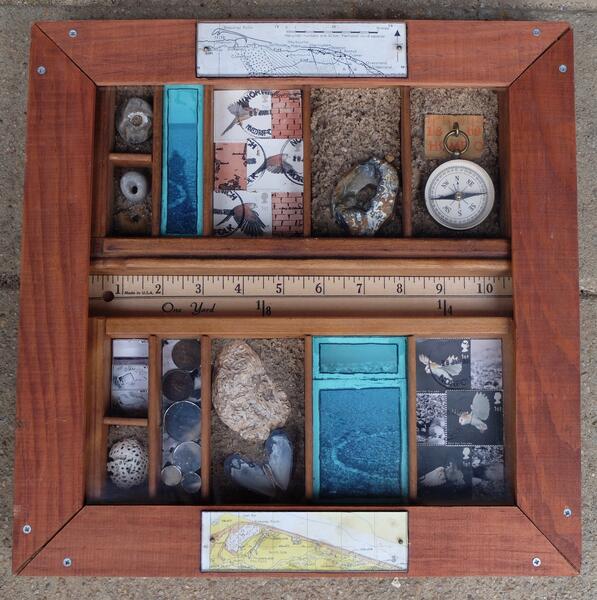 Blakeney Point Box # L249 LF (2007)Box assemblage; flint, maps, stamps, compass, photographs of installations, sand 10"by 10"
Blakeney Point Box # L249 LF (2007)Box assemblage; flint, maps, stamps, compass, photographs of installations, sand 10"by 10" -
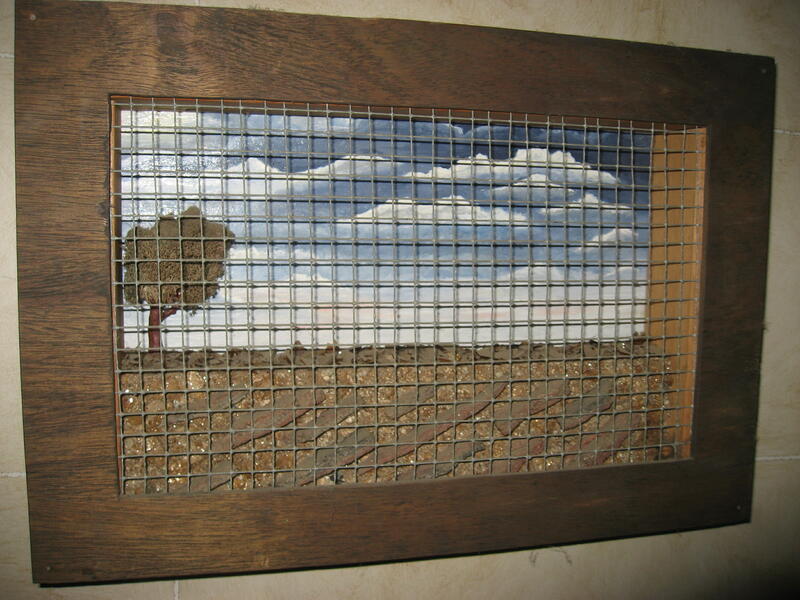 Death by cleavage III 1992Box assemblage; Stone, crushed mica, toy tree, oil painting on board. 16" by 10"
Death by cleavage III 1992Box assemblage; Stone, crushed mica, toy tree, oil painting on board. 16" by 10" -
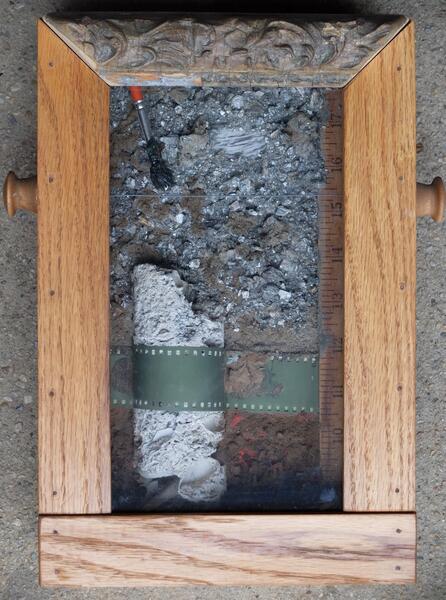 Black Gold 1992Box construction: red sandstone, mica, core sample (limestone), 35mm film, paintbrush, black and white photograph
Black Gold 1992Box construction: red sandstone, mica, core sample (limestone), 35mm film, paintbrush, black and white photograph -
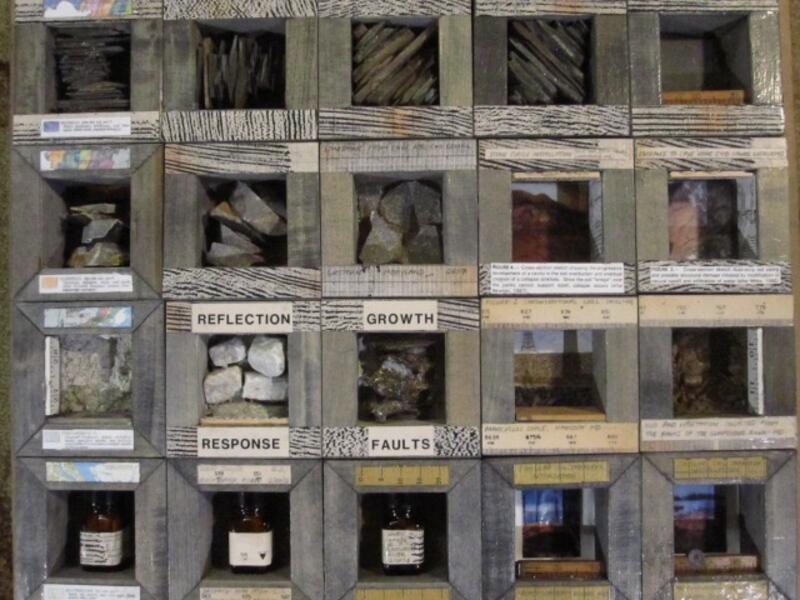 Box sketches 2014A series of 4" by 4" box sketches, containing stone, geology maps, photographs, water sample bottles. This series was inspired by the anti-fracking campaign in MD and talks about the relationship between man and water pollution. This Piece won first prize in the bridges in science exhibition (2014) put on by Towson Arts Collective.
Box sketches 2014A series of 4" by 4" box sketches, containing stone, geology maps, photographs, water sample bottles. This series was inspired by the anti-fracking campaign in MD and talks about the relationship between man and water pollution. This Piece won first prize in the bridges in science exhibition (2014) put on by Towson Arts Collective.
Preservation work with Chimney swifts and solitary Bees
This project highlights some of my work in helping preserve habitats for Chimney Swifts and Solitary Bees;
Baltimore has one of the biggest Chimney Swift migrations on the East Coast. Here in Hampden we had to fight tooth and nail to ensure the Book Bindery Building on Elm St. was designated Historic thus preserving it's 70ft chimney. This chimney serves as a nightly resting place for thousands of Chimney swifts during their spring and summer migration to South America.
My work with solitary bees has involved designing and installing numerous solitary bee houses in parks and private gardens in Baltimore along with installing Pollinator/wildlife gardens throughout Maryland that provide food and habitat for bees, butterflies, clearwing moths and other pollinators. In addition to habitat and food for birds.
-
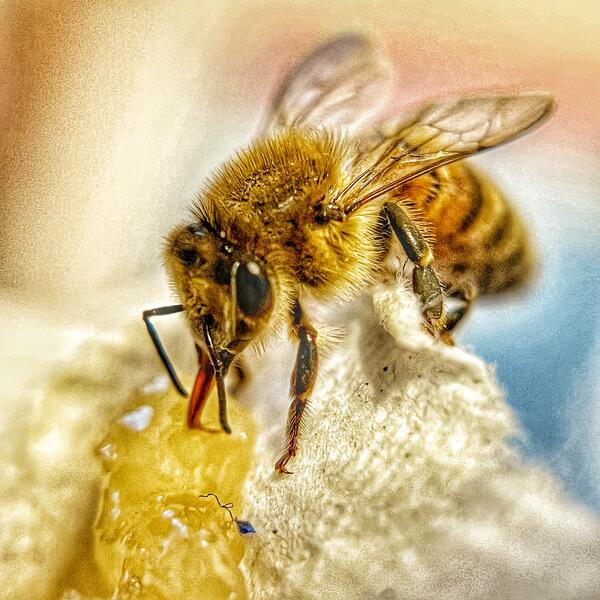 Portrait of a honey bee (Apis mellifera)
Portrait of a honey bee (Apis mellifera)This photo shows a honey bee that accidentally made it's way into my studio and was struggling. I fed it local honey and released it.
-
 Sketch for solitary bee house
Sketch for solitary bee houseSketch for solitary bee house
-
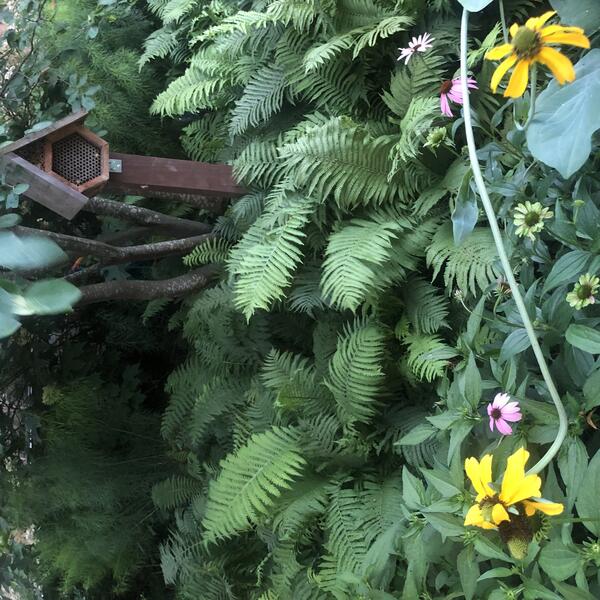 Solitary Bee House in Artist's garden
Solitary Bee House in Artist's garden -
Chaetura Pelagica (Chimney Swift) habitat destruction
Video of chimney swift installation in my studio, featuring the stoney run coffin.
-
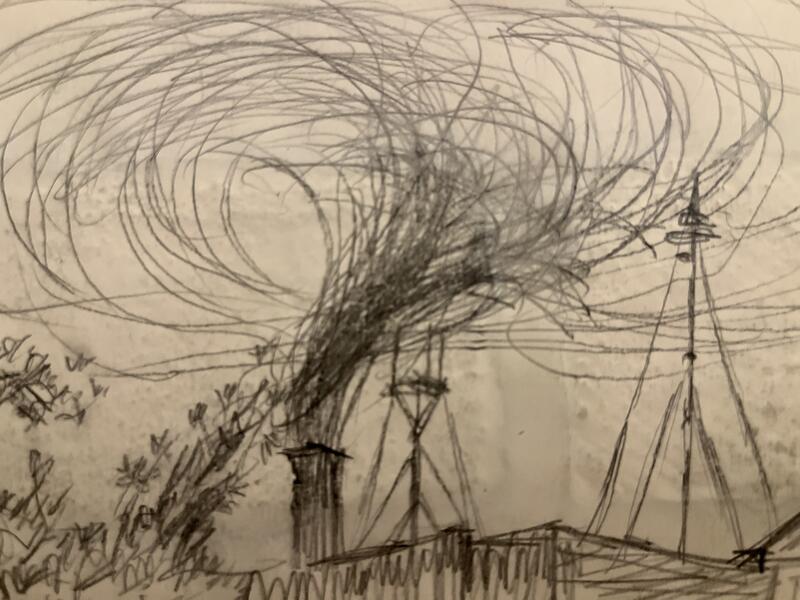 Sketch of Book Bindery building Chimney with Swift murmuration before evening descent, sept 2022
Sketch of Book Bindery building Chimney with Swift murmuration before evening descent, sept 2022 -
Megachile Species (leafcutter bees) cleaning 2022Leafcutter Bees cleaning right after hatching in springtime
-
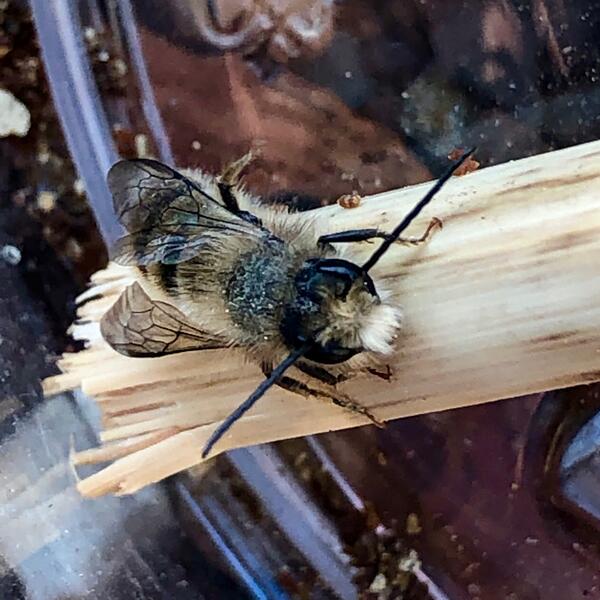 Megachile species (leaf cutter bee)This photo shows a leaf cutter bee soon after hatching, the eggs had been kept in my fridge during the winter! This photo was used in the bee house making workshop I gave at the Peale Center, Baltimore MD in 2018.
Megachile species (leaf cutter bee)This photo shows a leaf cutter bee soon after hatching, the eggs had been kept in my fridge during the winter! This photo was used in the bee house making workshop I gave at the Peale Center, Baltimore MD in 2018. -
 Leafcutter bee eggs in grass stems
Leafcutter bee eggs in grass stemsThis picture shows leaf cutter bee eggs in grass stems, the eggs are surrounded by pollen and are separated by mud packs. This was from another bee house constructed at the Art on the Farm workshop and installed in my garden.
-
 Chaetura Pelegica installation
Chaetura Pelegica installationInstallation at my studio about the chimney swifts and their autumn migration stop in Baltimore's book bindery chimney; Watercolor, brick and sand, 2022
-
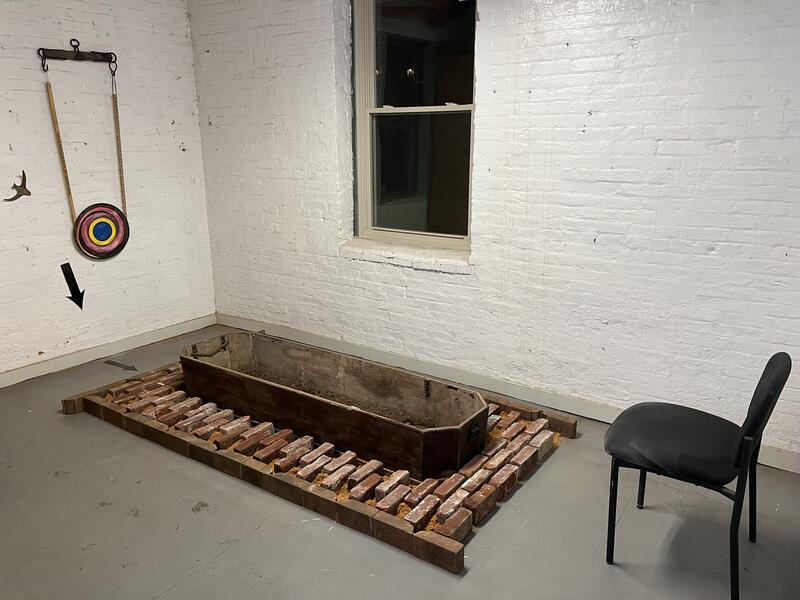 Chautura Pelegrina
Chautura PelegrinaInstallation at my studio about the chimney swifts and their autumn migration stop in Baltimore's book bindery chimney; Watercolor, brick and sand, 2022
Nature Art in the Park (Leakin Park), Art on the Trail (Lake Roland Park) and other installations installed in US
These works are part of the Art on the Trail series of installations at Lake Roland Park, Baltimore and Nature Art in the Park work in Leakin Park, Baltimore (2014 to Present). They include my Pollinator Hexagon series of installations. In addition to other work installed in the US.
https://chesapeakebaymagazine.com/art-on-the-waterfront-brings-inspired-outdoor-art-to-south-baltimore/
-
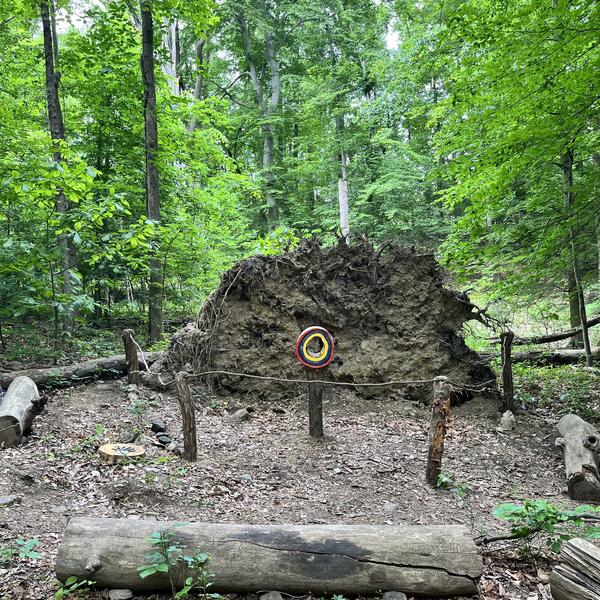 Monument to a Fallen Oak
Monument to a Fallen OakMonument to a Fallen Oak, 2023, mixed media installation, (130ft by 35ft by 8ft) for Nature Art in the Park 2023
-
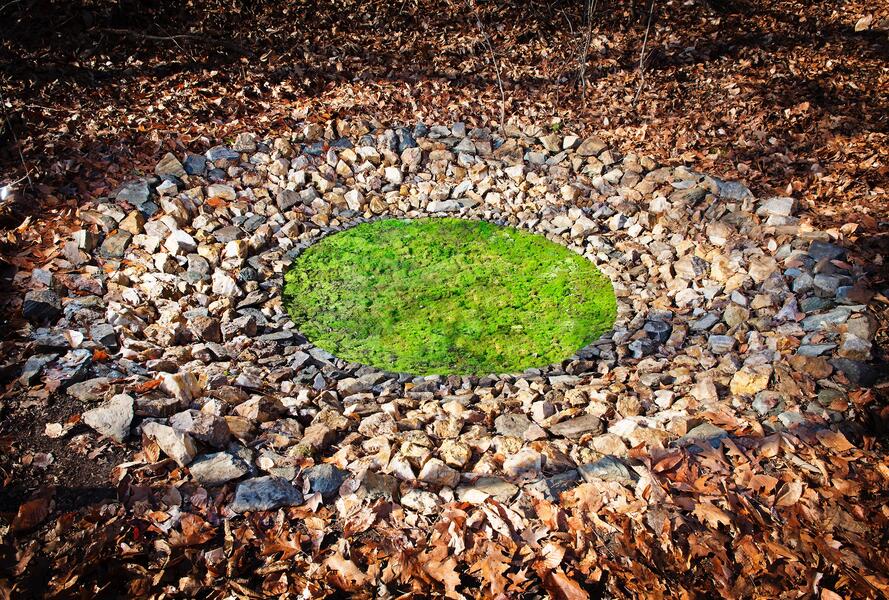 Earth Transfer(second phase) Anti-cline (2015)Earth transfer installed at Lake Roland moss and stone 12ft diameter
Earth Transfer(second phase) Anti-cline (2015)Earth transfer installed at Lake Roland moss and stone 12ft diameter -
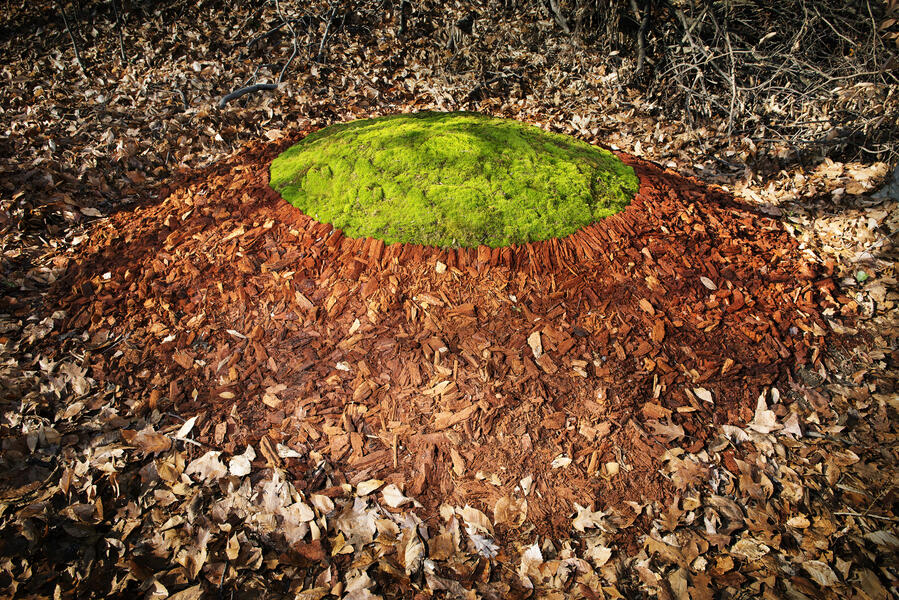 Earth transfer with stone, wood and mossInstalled at Lake Roland for Art on the Trail exhibit Northern mound or barrow; Fall phase; 12ft diameter moss circle surrounded by rotting cedar mulch found nearby. Photo by greg Dohler
Earth transfer with stone, wood and mossInstalled at Lake Roland for Art on the Trail exhibit Northern mound or barrow; Fall phase; 12ft diameter moss circle surrounded by rotting cedar mulch found nearby. Photo by greg Dohler -
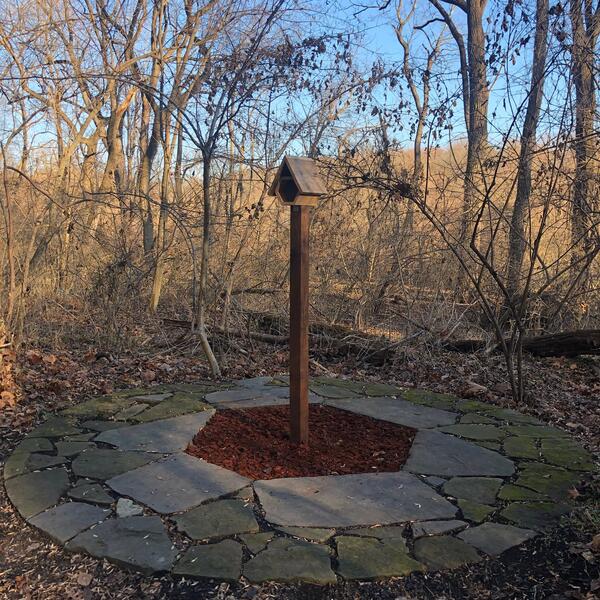 Pollinator hexagon I with solitary bee house (2019)My pollinator hexagon I installation has the addition of a solitary bee house above replanted pycanthemum viginianum (mountain mint).
Pollinator hexagon I with solitary bee house (2019)My pollinator hexagon I installation has the addition of a solitary bee house above replanted pycanthemum viginianum (mountain mint). -
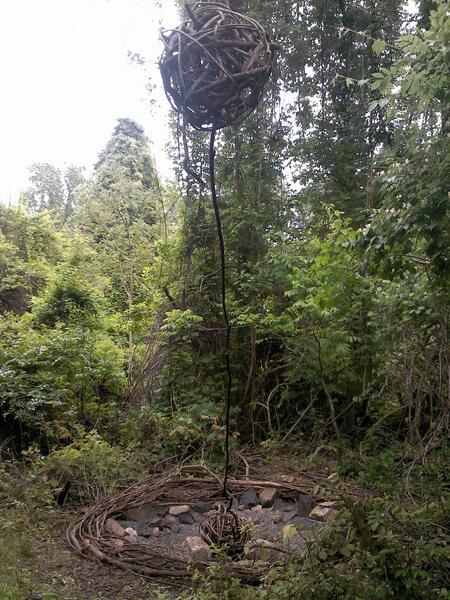 Well of Passion, 2014Well of Passion, Nature Art in the Park 2014. Vine balls constructed from wisteria vines, gravel and boulders.
Well of Passion, 2014Well of Passion, Nature Art in the Park 2014. Vine balls constructed from wisteria vines, gravel and boulders. -
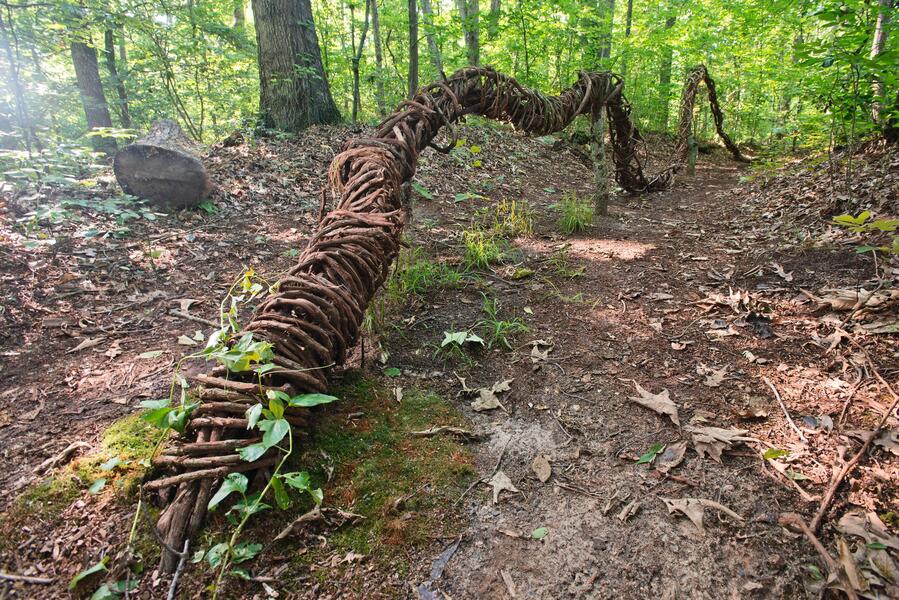 Swalevine 2016, Adkins Arboretum,MDThis installation was part of the "Artists in dialogue with nature" outdoor invitational at Adkins Arboretum, installed in late spring/early summer 2016. The installation was constructed using mainly non-native grape vines cut from the surrounding forest. The vines were twisted together to form a long (approx 85'), snaking sculpture which followed the course of a swale which may have been a road at some point in time. In the construction of the installation, dead branches were blown off and dropped into the swale, these branches were dug into the ground and used to support the heavy mass of vines. The sculpture was deemed finished when the vines became too heavy to manipulate. The native vine passionflower (passiflora incarnata), was planted at the beginning of the swalevine. The installation brings up the subject of native and non-native species and their battle for dominance in the american ecosystem.
Swalevine 2016, Adkins Arboretum,MDThis installation was part of the "Artists in dialogue with nature" outdoor invitational at Adkins Arboretum, installed in late spring/early summer 2016. The installation was constructed using mainly non-native grape vines cut from the surrounding forest. The vines were twisted together to form a long (approx 85'), snaking sculpture which followed the course of a swale which may have been a road at some point in time. In the construction of the installation, dead branches were blown off and dropped into the swale, these branches were dug into the ground and used to support the heavy mass of vines. The sculpture was deemed finished when the vines became too heavy to manipulate. The native vine passionflower (passiflora incarnata), was planted at the beginning of the swalevine. The installation brings up the subject of native and non-native species and their battle for dominance in the american ecosystem. -
Pollinator Hexagon IVPollinator Hexagon IV (2018); Installed for the Art on the Waterfront show in Middle branch Park. The stone was delaware river gravel. Central zone; Rudbeckia maxima (giant coneflower) Middle zones; Echinacea purpurea "magnus" (purple coneflower) Outer zones Asclepias tuberosa (butterfly weed)
-
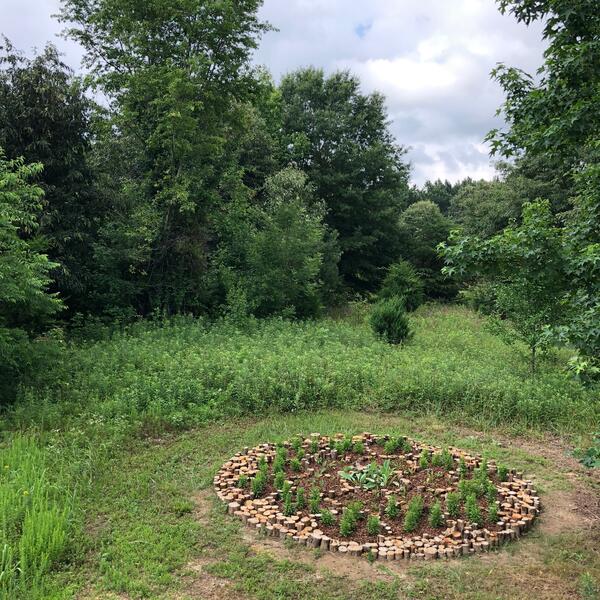 Pollinator Hexagon VPollinator Hexagon V (2018); Installed for the Artists in Dialogue with Nature show at Adkins Arboretum, Ridgely MD. The dead wood was collected from around the Arboretum and was a mixture of loblolly pine, red maple and other native trees. Central zone; Rudbeckia maxima (giant cone flower), Middle zones Echinacea purpurea "rubinstern" (purple coneflower) outer zones; Solidago hybrida "little lemon" (Little lomon goldenrod)
Pollinator Hexagon VPollinator Hexagon V (2018); Installed for the Artists in Dialogue with Nature show at Adkins Arboretum, Ridgely MD. The dead wood was collected from around the Arboretum and was a mixture of loblolly pine, red maple and other native trees. Central zone; Rudbeckia maxima (giant cone flower), Middle zones Echinacea purpurea "rubinstern" (purple coneflower) outer zones; Solidago hybrida "little lemon" (Little lomon goldenrod) -
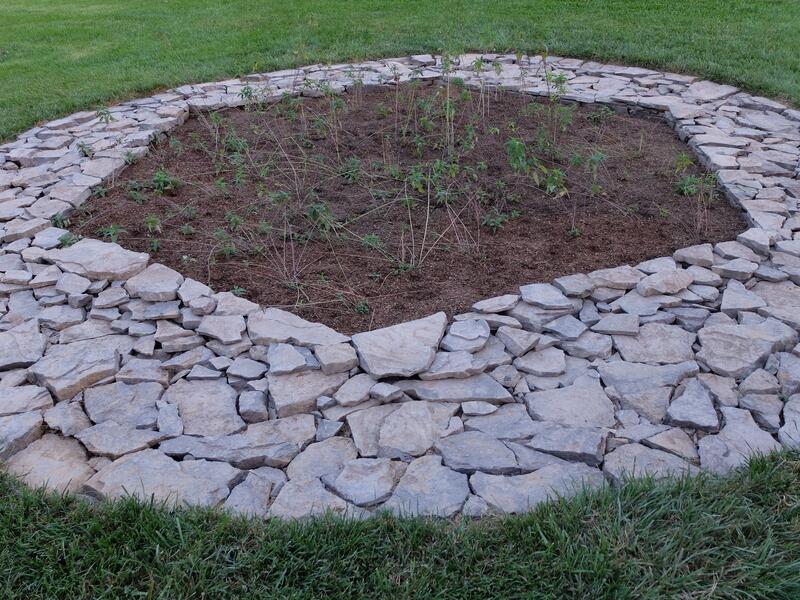 Pollinator Hexagon IIThis installation was part of the 2017 Inside/Out sculpture show at Montpellier Arts center in Laurel, MD. The stone used was colonial wallstone and the perennials were Monarda fistulosa (wild bergamont)
Pollinator Hexagon IIThis installation was part of the 2017 Inside/Out sculpture show at Montpellier Arts center in Laurel, MD. The stone used was colonial wallstone and the perennials were Monarda fistulosa (wild bergamont) -
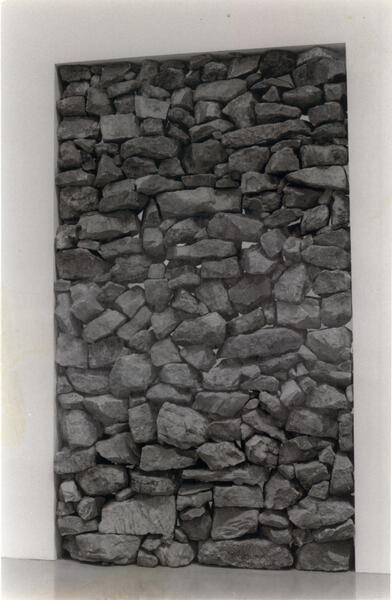 Jannis Kounellis stone wall 2002This wall was installed as part of the 2002 Arte Povera show in the Hirshhorn museum in DC. We followed the instructions of the artist to create a free standing dry laid wall that was visible from both sides using local stone, in this case western MD fieldstone.
Jannis Kounellis stone wall 2002This wall was installed as part of the 2002 Arte Povera show in the Hirshhorn museum in DC. We followed the instructions of the artist to create a free standing dry laid wall that was visible from both sides using local stone, in this case western MD fieldstone.
Earth Works installed in Reykjavik, Iceland and the UK
Blakeney Point Flint Project #5 was the culmination of 4 previous installations (or sketches) in exactly the same location on Blakeney Point in Norfolk, UK. The installation was a homage to the Neolithic stone circles found throughout the British Iles.
2009 Basaltic Hexagon project; Basalt stones were collected and placed in a hexagonal pattern, each hexagon approx. 3ft in width. The pattern reflects the nature of basalt when emerging from the earth, it often forms large hexagonal layers. The installation was started at low tide, I then worked until high tide started to lap on to the completed hexagons.
2014 The worship of Basalt I and II; Location directly at the end of runway for Reykjavik airport. A large basalt boulder (approx. 3ft long) lying secluded from the surrounding rocks was selected for the installation. Small basalt stones with kelp attached were selected then dragged across the sand and placed with the stones facing the boulder. The action of dragging the stones across the sand (which had a light dusting of snow on it) left interesting lines on the beach. The installation was performed 2 times on consecutive days (high tide washing away the stones overnight); in part 1 a hexagon was formed around the boulder, in part 2 the shape was an outline of the boulder.
-
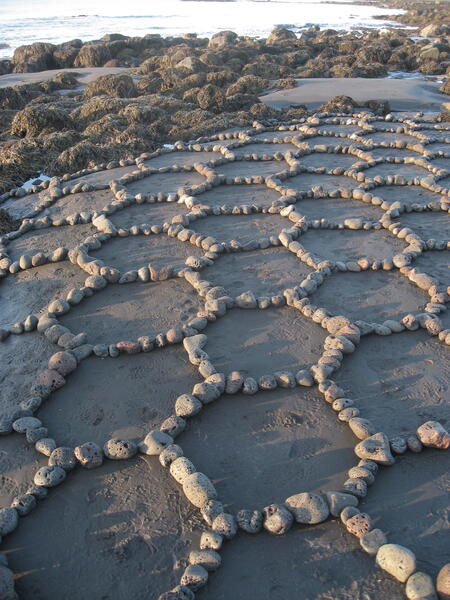 Basaltic Hexagon project 2009Basalt stones arranged in hexagonal form at low tide, late afternoon.
Basaltic Hexagon project 2009Basalt stones arranged in hexagonal form at low tide, late afternoon. -
 Blakeney Point Flint Project #5 2007Photograph taken from the dunes just above the installation.Cairn, henge and stonework completed, fire lit and burning in the late afternoon.
Blakeney Point Flint Project #5 2007Photograph taken from the dunes just above the installation.Cairn, henge and stonework completed, fire lit and burning in the late afternoon. -
Blakeney point flint project #5 2007
This photograph shows a close up of the installation after the central fire had burned.
-
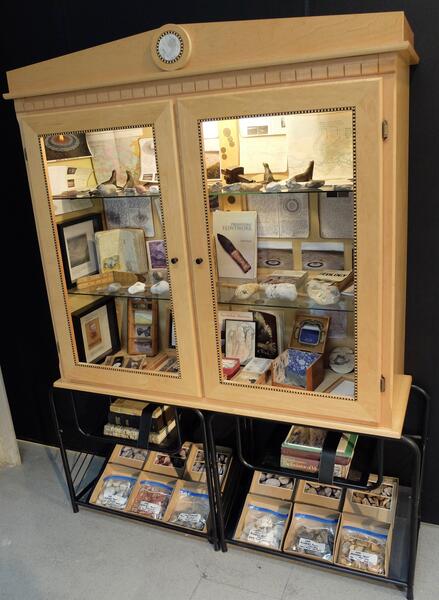 Blakeney Point Flint project cabinet installed for Artscape 2017 Fieldwork Exhibtion.
Blakeney Point Flint project cabinet installed for Artscape 2017 Fieldwork Exhibtion.This cabinet installation was exhibited as part of the Fieldwork exhibition for Artscape 2017. It contained photographs, sketches, samples of flint, box constructions and reference books all related to the Blakeney Point flint projects installed in Norfolk, England between 2003-2008.
-
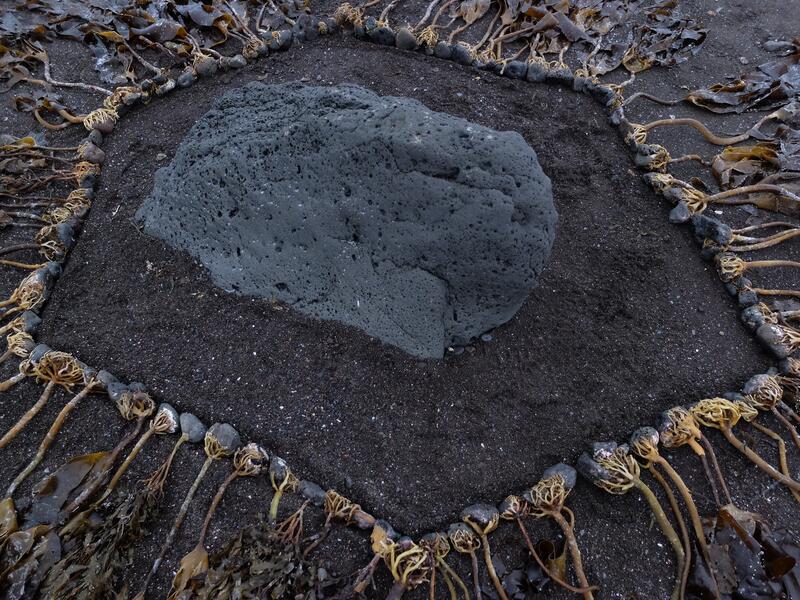 The worship of Basalt (pt. 1)THE WORSHIP OF BASALT (Pt. 1) 2014 Installed on the Beach near Reykjavik airport, Reykjavik, Iceland. Basalt boulder surrounded by small basalt stones with kelp attached. The hexagonal shape reflects the form basalt takes when deposited in large layers on the sea floor.
The worship of Basalt (pt. 1)THE WORSHIP OF BASALT (Pt. 1) 2014 Installed on the Beach near Reykjavik airport, Reykjavik, Iceland. Basalt boulder surrounded by small basalt stones with kelp attached. The hexagonal shape reflects the form basalt takes when deposited in large layers on the sea floor. -
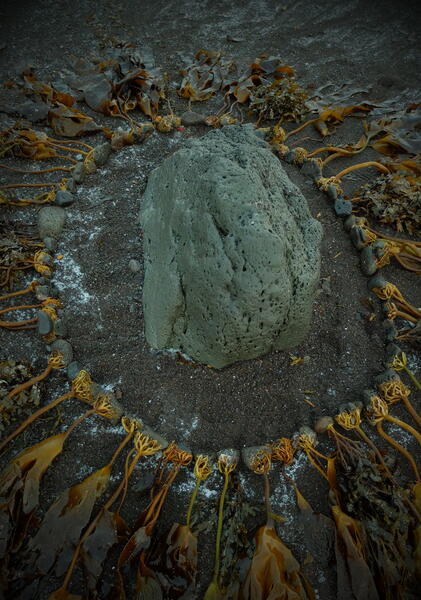 The worship of Basalt part 2The small basalt pebbles encircle and pay homage to the boulder
The worship of Basalt part 2The small basalt pebbles encircle and pay homage to the boulder -
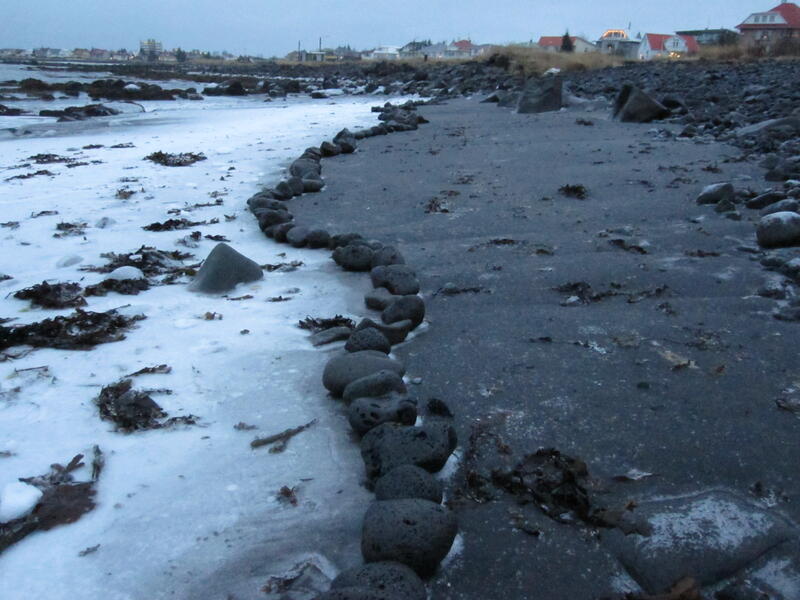 Basalt High Tide Marker 2010In this installation I walked along the beach at low tide and tried to guess at the location where high tide would come up to on the beach. Basalt stones were collected and placed to mark the positions. On return the next day I found my guesses to be correct, the atlantic ocean side of the stones were frozen while the landward side remained unfrozen. The effect was as if the stones had stopped the high tide at this point.
Basalt High Tide Marker 2010In this installation I walked along the beach at low tide and tried to guess at the location where high tide would come up to on the beach. Basalt stones were collected and placed to mark the positions. On return the next day I found my guesses to be correct, the atlantic ocean side of the stones were frozen while the landward side remained unfrozen. The effect was as if the stones had stopped the high tide at this point. -
 The worship of BasaltSmall basalt stones with kelp attached. The roots from the kelp were able to penetrate the porous basalt stones.
The worship of BasaltSmall basalt stones with kelp attached. The roots from the kelp were able to penetrate the porous basalt stones. -
 Stone Cairn (2022)This stone cairn (5ft tall max diameter 22") was built with a mix of stone, constructed dry laid (no mortar). It will be eventually converted into a bee friendly water feature.
Stone Cairn (2022)This stone cairn (5ft tall max diameter 22") was built with a mix of stone, constructed dry laid (no mortar). It will be eventually converted into a bee friendly water feature. -
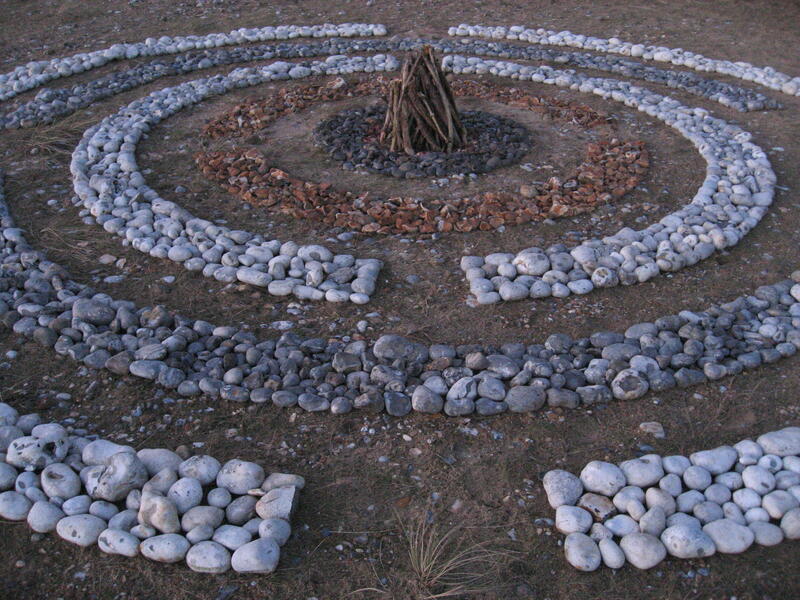 Blakeney Point flint project #4 2007Photo looking along north/south axis of installation.
Blakeney Point flint project #4 2007Photo looking along north/south axis of installation.
American Installations
Here's a link to the Chesapeake Bay Magazine review of Art on the Waterfront (2018) featuring my Pollinator Hexagon V installation
https://chesapeakebaymagazine.com/art-on-the-waterfront-brings-inspired-outdoor-art-to-south-baltimore/
-
Pollinator Hexagon IVPollinator Hexagon IV (2018); Installed for the Art on the Waterfront show in Middle branch Park. The stone was delaware river gravel. Central zone; Rudbeckia maxima (giant coneflower) Middle zones; Echinacea purpurea "magnus" (purple coneflower) Outer zones Asclepias tuberosa (butterfly weed)
-
 Jannis Kounellis stone wall 2002This wall was installed as part of the 2002 Arte Povera show in the Hirshhorn museum in DC. We followed the instructions of the artist to create a free standing dry laid wall that was visible from both sides using local stone, in this case western MD fieldstone.
Jannis Kounellis stone wall 2002This wall was installed as part of the 2002 Arte Povera show in the Hirshhorn museum in DC. We followed the instructions of the artist to create a free standing dry laid wall that was visible from both sides using local stone, in this case western MD fieldstone. -
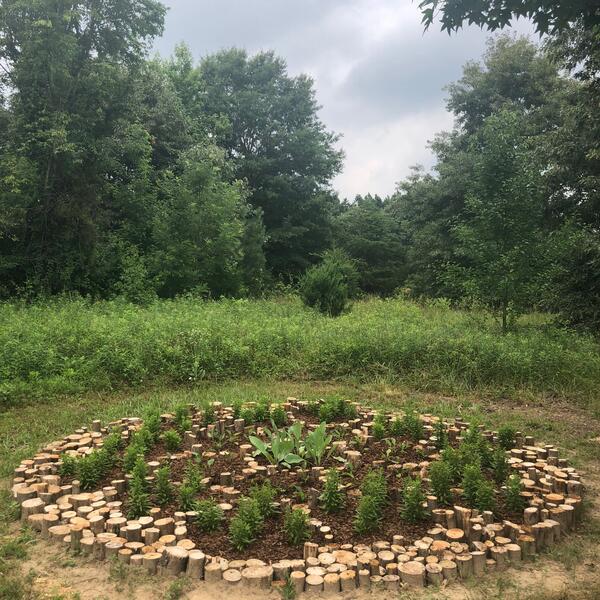 Pollinator Hexagon VInstalled at Adkins Arboretum on the Eastern shore of MD in 2018 for the Artists in dialogue with Nature sculpture exhibitio. The installation features found wood usded to construct the hexagon and native plants to attract pollinators.
Pollinator Hexagon VInstalled at Adkins Arboretum on the Eastern shore of MD in 2018 for the Artists in dialogue with Nature sculpture exhibitio. The installation features found wood usded to construct the hexagon and native plants to attract pollinators. -
 Swalevine 2016, Adkins Arboretum,MDThis installation was part of the "Artists in dialogue with nature" outdoor invitational at Adkins Arboretum, installed in late spring/early summer 2016. The installation was constructed using mainly non-native grape vines cut from the surrounding forest. The vines were twisted together to form a long (approx 85'), snaking sculpture which followed the course of a swale which may have been a road at some point in time. In the construction of the installation, dead branches were blown off and dropped into the swale, these branches were dug into the ground and used to support the heavy mass of vines. The sculpture was deemed finished when the vines became too heavy to manipulate. The native vine passionflower (passiflora incarnata), was planted at the beginning of the swalevine. The installation brings up the subject of native and non-native species and their battle for dominance in the american ecosystem.
Swalevine 2016, Adkins Arboretum,MDThis installation was part of the "Artists in dialogue with nature" outdoor invitational at Adkins Arboretum, installed in late spring/early summer 2016. The installation was constructed using mainly non-native grape vines cut from the surrounding forest. The vines were twisted together to form a long (approx 85'), snaking sculpture which followed the course of a swale which may have been a road at some point in time. In the construction of the installation, dead branches were blown off and dropped into the swale, these branches were dug into the ground and used to support the heavy mass of vines. The sculpture was deemed finished when the vines became too heavy to manipulate. The native vine passionflower (passiflora incarnata), was planted at the beginning of the swalevine. The installation brings up the subject of native and non-native species and their battle for dominance in the american ecosystem. -
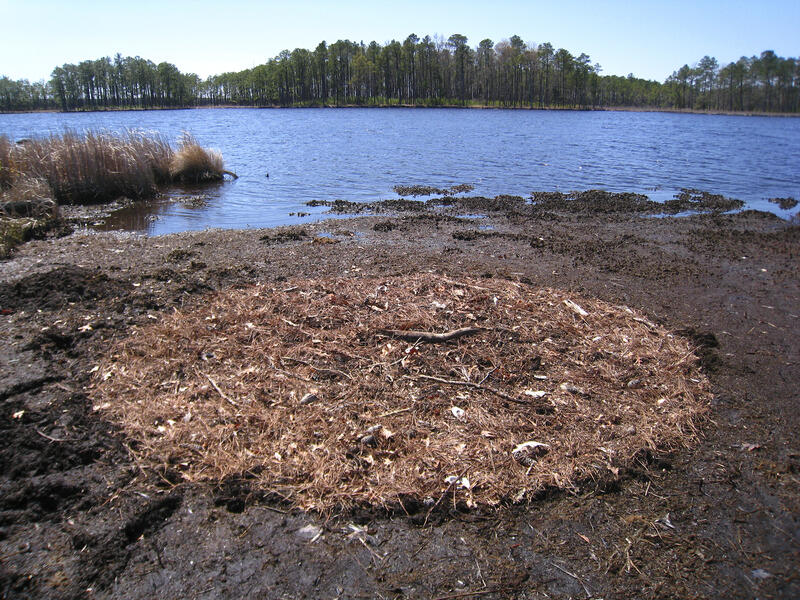 Blackwater project 2009North side of river This photo shows the leaves transported from the south side of the river and placed in a 10ft diameter circle on the north side of the Blackwater river. This piece talks about the runoff of fertilizer from farmland close to the river and the continuing pollution of the Chesapeake Bay.
Blackwater project 2009North side of river This photo shows the leaves transported from the south side of the river and placed in a 10ft diameter circle on the north side of the Blackwater river. This piece talks about the runoff of fertilizer from farmland close to the river and the continuing pollution of the Chesapeake Bay. -
 Blackwater project 2009Southern side of river; Blackwater River on the Eastern shore of Maryland. This project involved transferring 2 circles of surface debris (10ft in diameter) from one side of the Blackwater river to the other. This was done using a kayak towing a small barge. This photo shows the fine mud transported from the north side of the river and placed in a circle on the south side.
Blackwater project 2009Southern side of river; Blackwater River on the Eastern shore of Maryland. This project involved transferring 2 circles of surface debris (10ft in diameter) from one side of the Blackwater river to the other. This was done using a kayak towing a small barge. This photo shows the fine mud transported from the north side of the river and placed in a circle on the south side. -
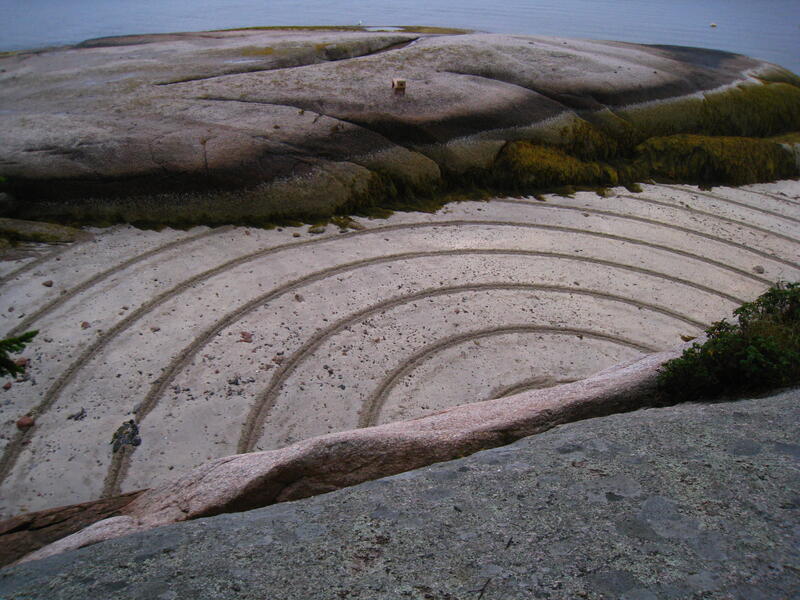 Beach circles, Deer Isles MA 2009Circles in sand on the beach in Deer Isles. MA
Beach circles, Deer Isles MA 2009Circles in sand on the beach in Deer Isles. MA -
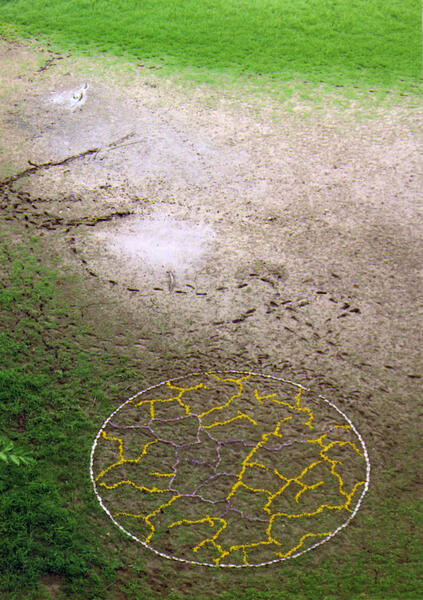 Gunpowder River project 2007Installation on the Gunpowder river, Phoenix MD. Sneezeweed flowers, freshwater mussels and butterfly weed used to mark the mud cracks on the Gunpowder river. The mussels marked out a 20ft diameter circle on the river bed while the level was low.
Gunpowder River project 2007Installation on the Gunpowder river, Phoenix MD. Sneezeweed flowers, freshwater mussels and butterfly weed used to mark the mud cracks on the Gunpowder river. The mussels marked out a 20ft diameter circle on the river bed while the level was low.
Watercolors
The watercolors presented in this project are all recent ( 2019-2023) with some inspired by my interest in mutation. My recent work, as a response to the Covid 19 pandemic, has produced a series of works inspired by nature but often featuring strange twists or mutations. Some of these drawings and paintings were started after I had a medical procedure to insert a small tube in my body where a large aneurysm had developed.
-
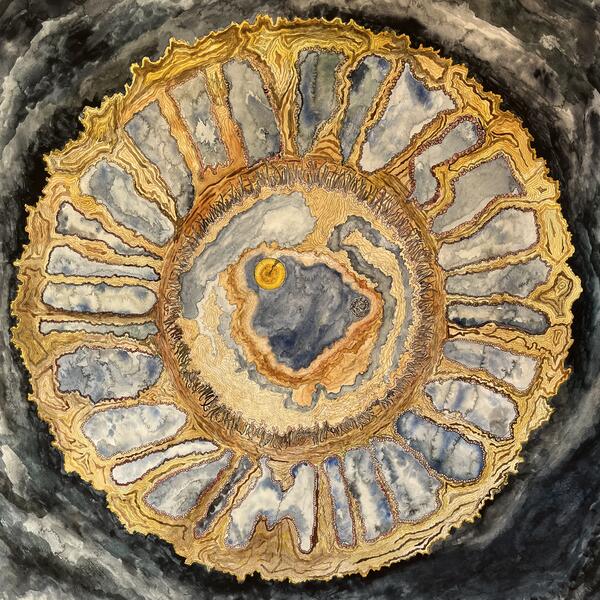 The expansion of the universe 2022THE EXPANSION OF THE UNIVERSE (2022); Pencil, Ink and watercolor on paper, 42"by 42" This work was inspired by the amazing photographs from the space telescope Hubble and most recently Webb.
The expansion of the universe 2022THE EXPANSION OF THE UNIVERSE (2022); Pencil, Ink and watercolor on paper, 42"by 42" This work was inspired by the amazing photographs from the space telescope Hubble and most recently Webb. -
Death of a Cactus
-
Angliacus anglicanna naturalis
Angliacus anglicanna naturalis, 2021 Iliacus anglicanna naturalis, 2021 Pencil, Ink and watercolor on paper (24" by 42")
-
 Oak seed Mutation, 2021Pencil, ink and watercolor on paper, 22" by 42".
Oak seed Mutation, 2021Pencil, ink and watercolor on paper, 22" by 42". -
Feather mutation (2022)Pencil, Ink and watercolor on paper (2021). 24" by 44"
-
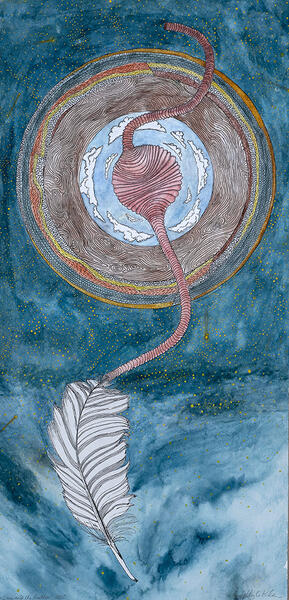 The Lung and Feather 2020Pencil, ink and watercolor. 36" by 18"
The Lung and Feather 2020Pencil, ink and watercolor. 36" by 18" -
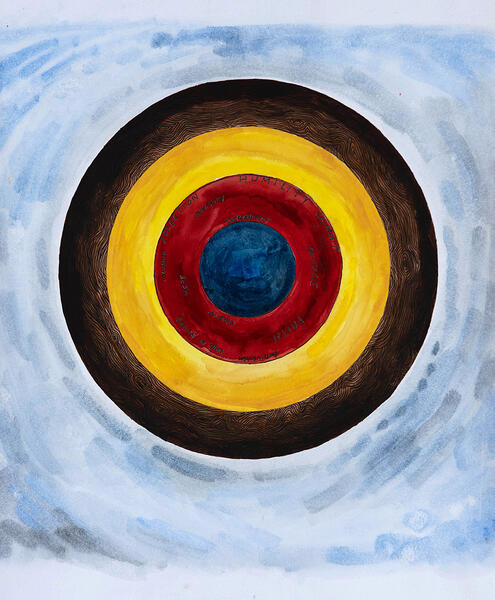 The colors of the soul (2019)This watercolor (18" by 18") is from a series I've been working on drawing influence from a book about the soul, which was acquired by the Dutch art collector George Loudon. The book was on display at an exhibition at the Whitechapel Gallery, London in 2019 but viewers only able to read 1 page. At the time I was awaiting an operation to remove a large aneurysm in my left iliac and became fascinated with the notes in the book describing different soul colors, there supposedly being only red, blue, yellow and brown.
The colors of the soul (2019)This watercolor (18" by 18") is from a series I've been working on drawing influence from a book about the soul, which was acquired by the Dutch art collector George Loudon. The book was on display at an exhibition at the Whitechapel Gallery, London in 2019 but viewers only able to read 1 page. At the time I was awaiting an operation to remove a large aneurysm in my left iliac and became fascinated with the notes in the book describing different soul colors, there supposedly being only red, blue, yellow and brown. -
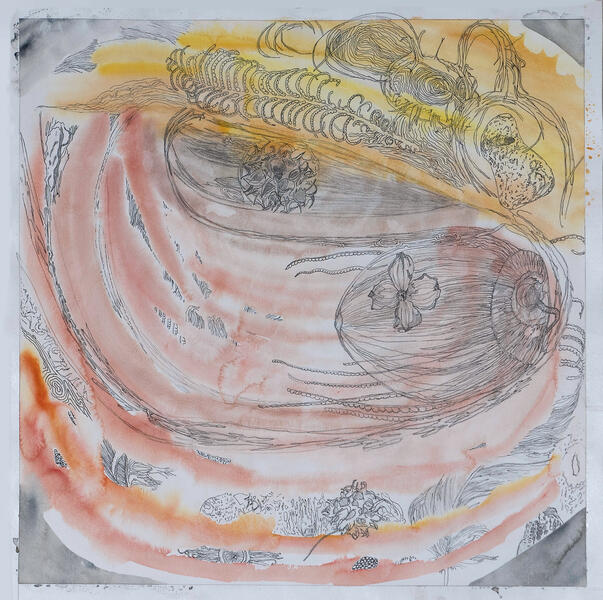 Acorn mutation (2021)Acorn Mutation (2021) Watercolor, pencil and ink on paper 24" by24"
Acorn mutation (2021)Acorn Mutation (2021) Watercolor, pencil and ink on paper 24" by24" -
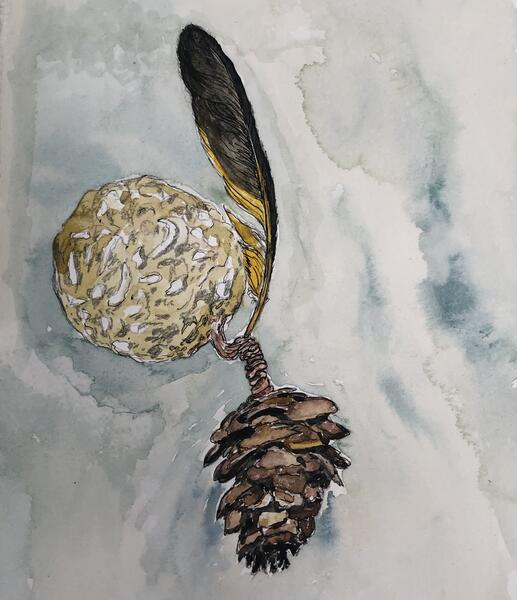 Praying feather
Praying featherWatercolor on paper, 10" by 8", 2022
-
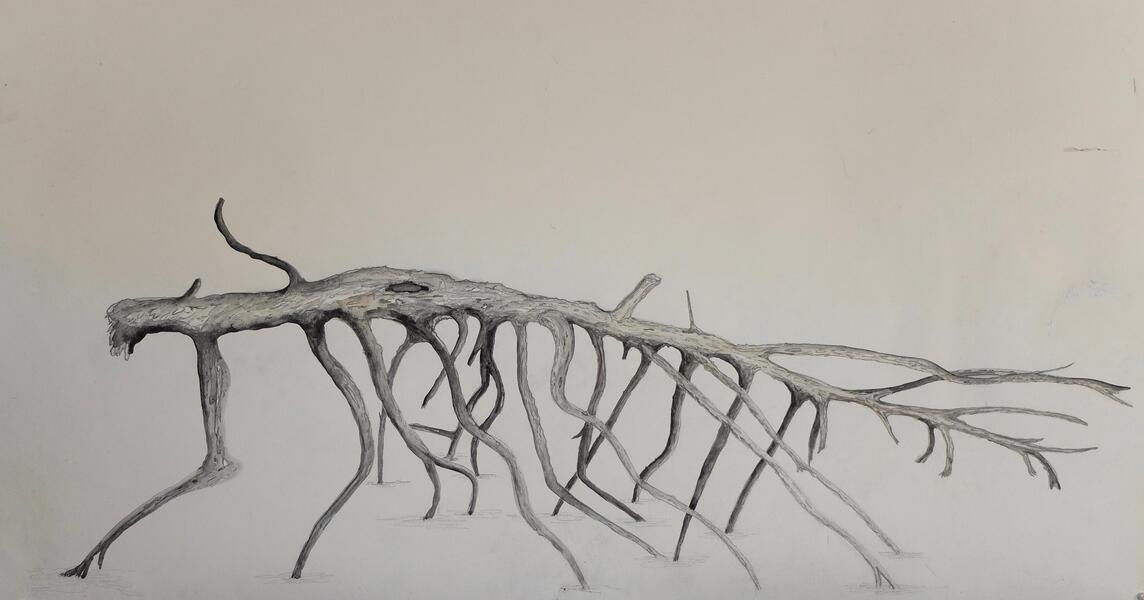 Hambleton Island Project
Hambleton Island ProjectPencil, watercolor on paper, 20" by 30"
Earthworks installed in the United Kingdom
-
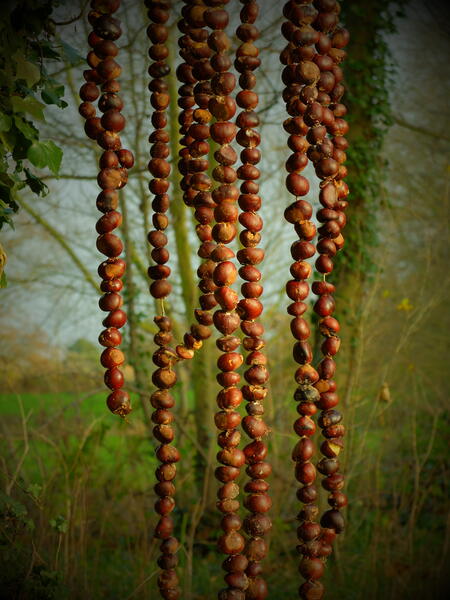 Chestnut Ivy installation 2014Installed on Bouldry's Island in the middle of the waveney river, which runs through Outney Common near Bungay, Suffolk, England. Chestnut "conkers" were attached to ivy hanging from a tree which had fallen, it's roots were eroded by the river.
Chestnut Ivy installation 2014Installed on Bouldry's Island in the middle of the waveney river, which runs through Outney Common near Bungay, Suffolk, England. Chestnut "conkers" were attached to ivy hanging from a tree which had fallen, it's roots were eroded by the river. -
 Marsh circle #2 2012Installed on Outney common, near Bungay, Suffolk, England. Cow manure used to mark a 24ft diameter circle in the grass
Marsh circle #2 2012Installed on Outney common, near Bungay, Suffolk, England. Cow manure used to mark a 24ft diameter circle in the grass -
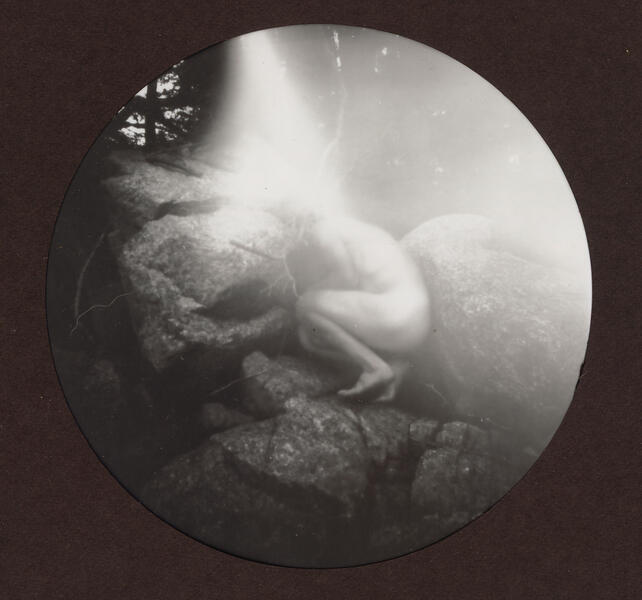 Kitnor (Hiding places by the seashore) 2009Pinhole photograph, Deer Isle, MA
Kitnor (Hiding places by the seashore) 2009Pinhole photograph, Deer Isle, MA -
 Kitnor (Hiding places by the seashore)Portloe, Cornwall, England
Kitnor (Hiding places by the seashore)Portloe, Cornwall, England -
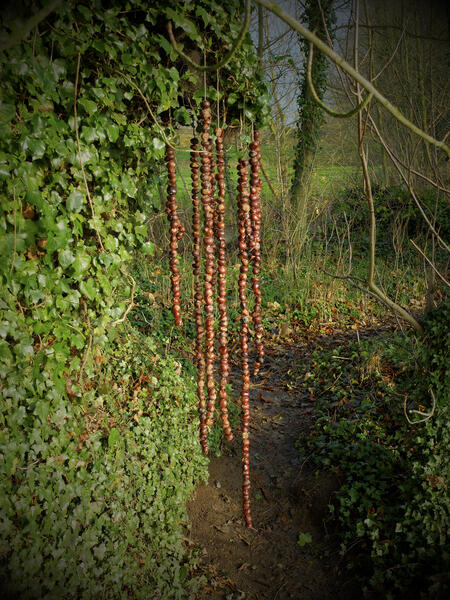 Chestnut Ivy installation 2014Bouldry's Island in the river Waveney on Outney Common, near Bungay, Suffolk, England. Chestnuts attached to ivy hanging from a fallen tree.
Chestnut Ivy installation 2014Bouldry's Island in the river Waveney on Outney Common, near Bungay, Suffolk, England. Chestnuts attached to ivy hanging from a fallen tree. -
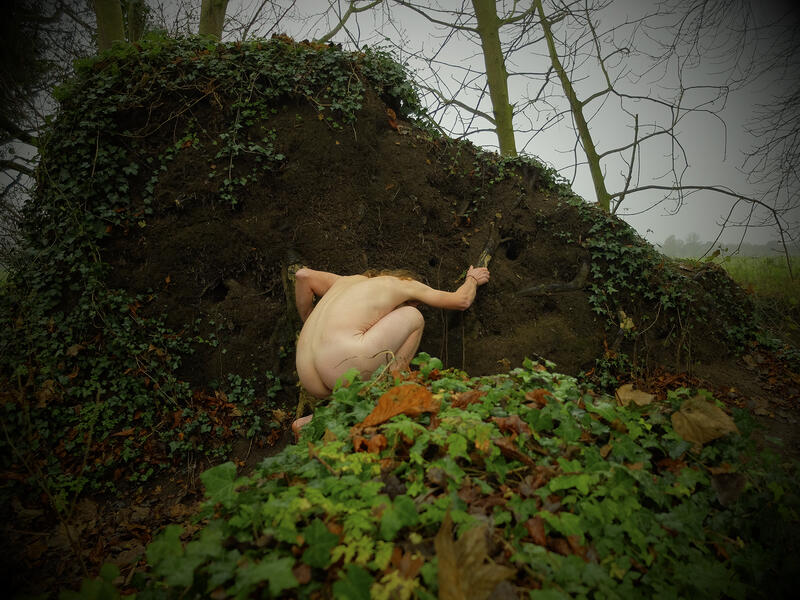 Kitnor (Hiding places by the Seashore) 2014Boulders Island, Waveney river, Near Bungay, Suffolk, England.
Kitnor (Hiding places by the Seashore) 2014Boulders Island, Waveney river, Near Bungay, Suffolk, England. -
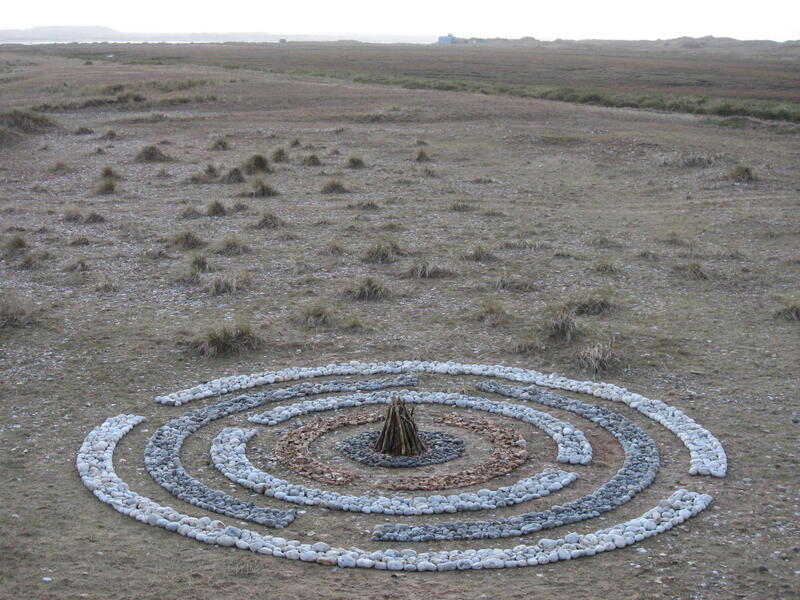 Blakeney Point flint project #4 2007Flint circles of different colors arranged on Blakeney Point, Norfolk, England, The gaps in the circles represent north and south.
Blakeney Point flint project #4 2007Flint circles of different colors arranged on Blakeney Point, Norfolk, England, The gaps in the circles represent north and south. -
 Blakeney Point flint project #4 2007Photo looking along north/south axis of installation.
Blakeney Point flint project #4 2007Photo looking along north/south axis of installation. -
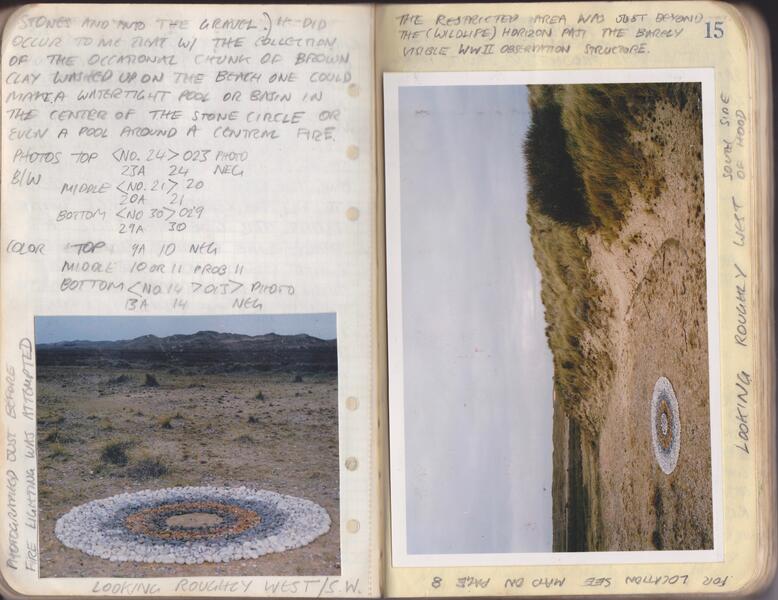 Blakeney Point Flint project #2, 2005Notes from sketch book on Blakeney Point flint Project #2
Blakeney Point Flint project #2, 2005Notes from sketch book on Blakeney Point flint Project #2 -
Blakeney Point flint project #6,Blakeney Point Flint project #6, 2008, Blakeney Point, Norfolk, England. In this installation the remnants of the previous project (#5) were formed into a simple 20ft diameter circle where all flints were removed to the outside leaving mainly sand within the circle
Blakeney Point Flint Project #5 (cairn with fire and henge) Norfolk, England, 2007. Including the Blakeney Point Flint Project cabinet for the Artscape 2017 Fieldwork exhibition.
Installed on Blakeney Point, Norfolk, England, December 28th-31st 2007.
Exhibited as part of Artscape 2017 fieldwork group show.
Circle diameter 20ft, height of cairn 3ft
Blakeney Point Flint Project #5 was the culmination of 4 previous installations (or sketches) in exactly the same location on the western side of a large sand dune just above normal high tide. Flint was collected from the surrounding area and sorted into 6 colors; white, blue, light blue, black, tan, red. The position of the cairn and henge were marked, sand was excavated from the henge to form the mound for the cairn. The different colored flints were then placed to form the outer circle (white), henge (blue) and cairn (light blue, black, tan and red). Washed up vegetation (jetsam and flotsam) were placed in the henge.
Dry driftwood was collected and used to build a fire on the top of the cairn. The installation was a homage to the Neolithic stone circles found throughout the British Iles.
-
 Blakeney Point Flint Project #5 2007Photograph taken from the dunes just above the installation.Cairn, henge and stonework completed, fire lit and burning in the late afternoon.
Blakeney Point Flint Project #5 2007Photograph taken from the dunes just above the installation.Cairn, henge and stonework completed, fire lit and burning in the late afternoon. -
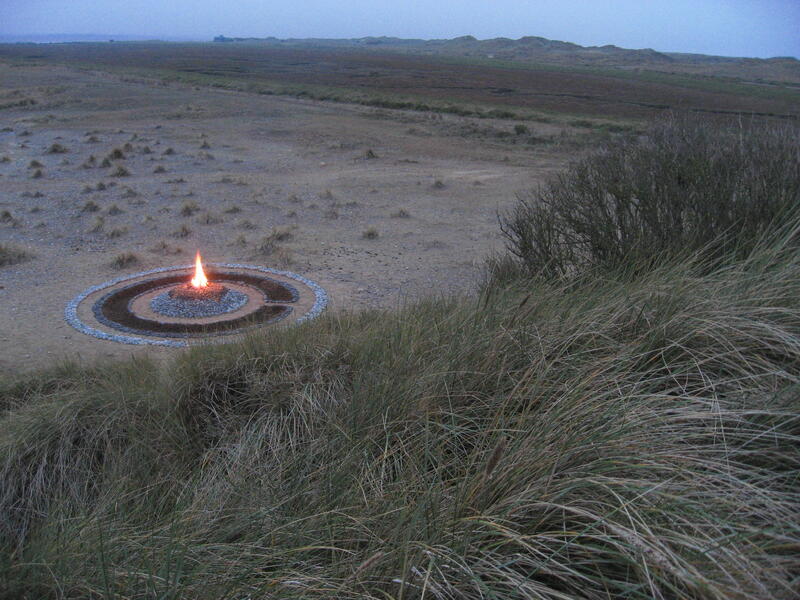 Blakeney Point flint project #5Photo taken from the sand dunes to the east
Blakeney Point flint project #5Photo taken from the sand dunes to the east -
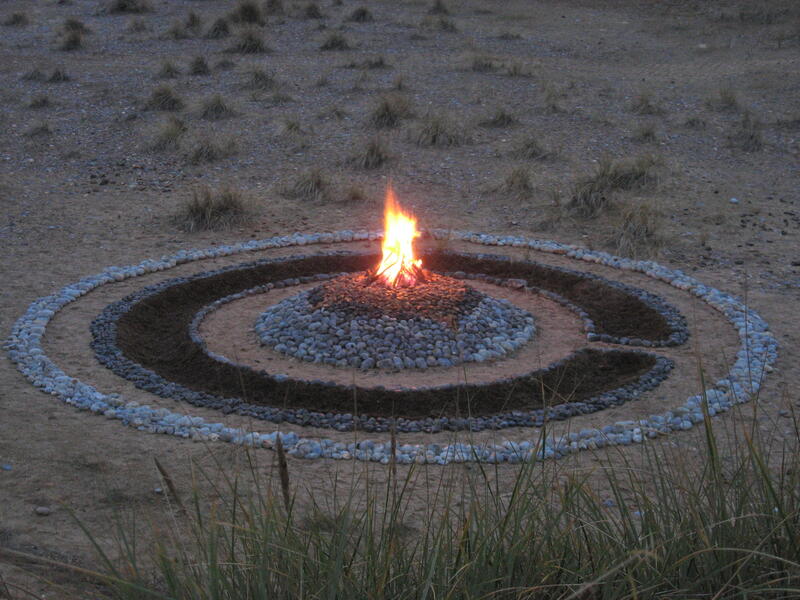 Blakeney Point flint project #5 2007Detail of mound or barrow with fire burning, the entrance (to the right of the picture) marks north.
Blakeney Point flint project #5 2007Detail of mound or barrow with fire burning, the entrance (to the right of the picture) marks north. -
 Blakeney Point Flint project cabinet installed for Artscape 2017 Fieldwork Exhibtion.
Blakeney Point Flint project cabinet installed for Artscape 2017 Fieldwork Exhibtion.This cabinet installation was exhibited as part of the Fieldwork exhibition for Artscape 2017. It contained photographs, sketches, samples of flint, box constructions and reference books all related to the Blakeney Point flint projects installed in Norfolk, England between 2003-2008.
-
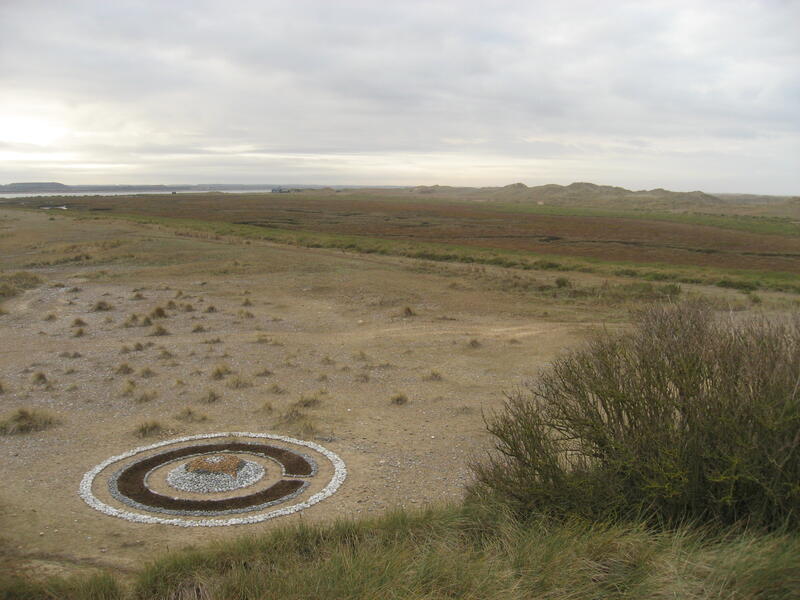 Blakeney Point flint project #53rd day after construction of Circle, henge and barrow.
Blakeney Point flint project #53rd day after construction of Circle, henge and barrow. -
Blakeney point flint project #5 2007
This photograph shows a close up of the installation after the central fire had burned.
-
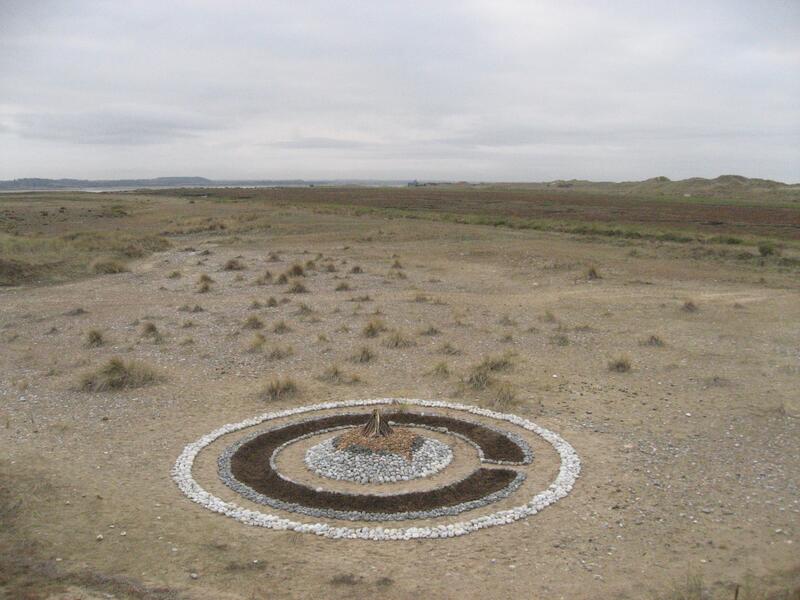 Blakeney Point flint project #5 2007Photo just before fire was lit
Blakeney Point flint project #5 2007Photo just before fire was lit -
 Bakeney Point Flint Project cabinet (detail), Part of the Artscape 2017 Fieldwork Exhibition
Bakeney Point Flint Project cabinet (detail), Part of the Artscape 2017 Fieldwork Exhibition -
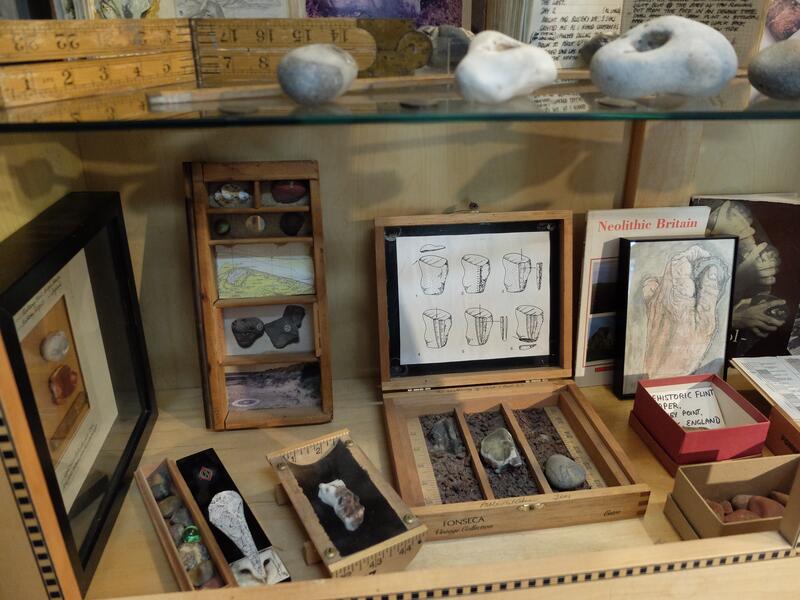 Blakeney Point Flint Project cabinet; detail.Detail of the Blakeney Point flint project cabinet installed for Artscape 2017 Fieldwork exhibition showing box constructions and flint samples
Blakeney Point Flint Project cabinet; detail.Detail of the Blakeney Point flint project cabinet installed for Artscape 2017 Fieldwork exhibition showing box constructions and flint samples -
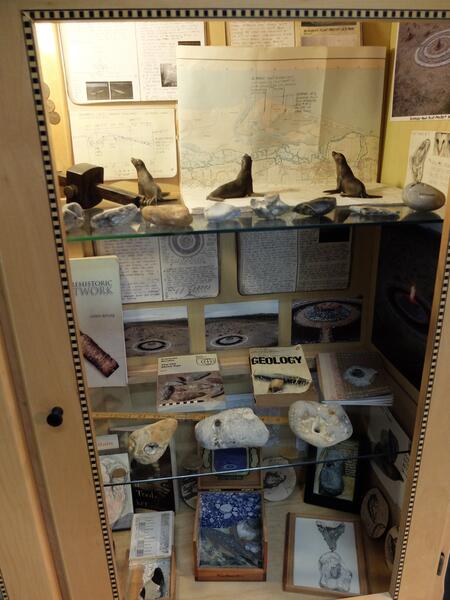 Blakeney Point Flint project cabinet (2017)Detail of the right side of the Blakeney Point flint project cabinet show at the Artscape 2017 Fieldwork exhibition in MICA's Bunting building.
Blakeney Point Flint project cabinet (2017)Detail of the right side of the Blakeney Point flint project cabinet show at the Artscape 2017 Fieldwork exhibition in MICA's Bunting building.
